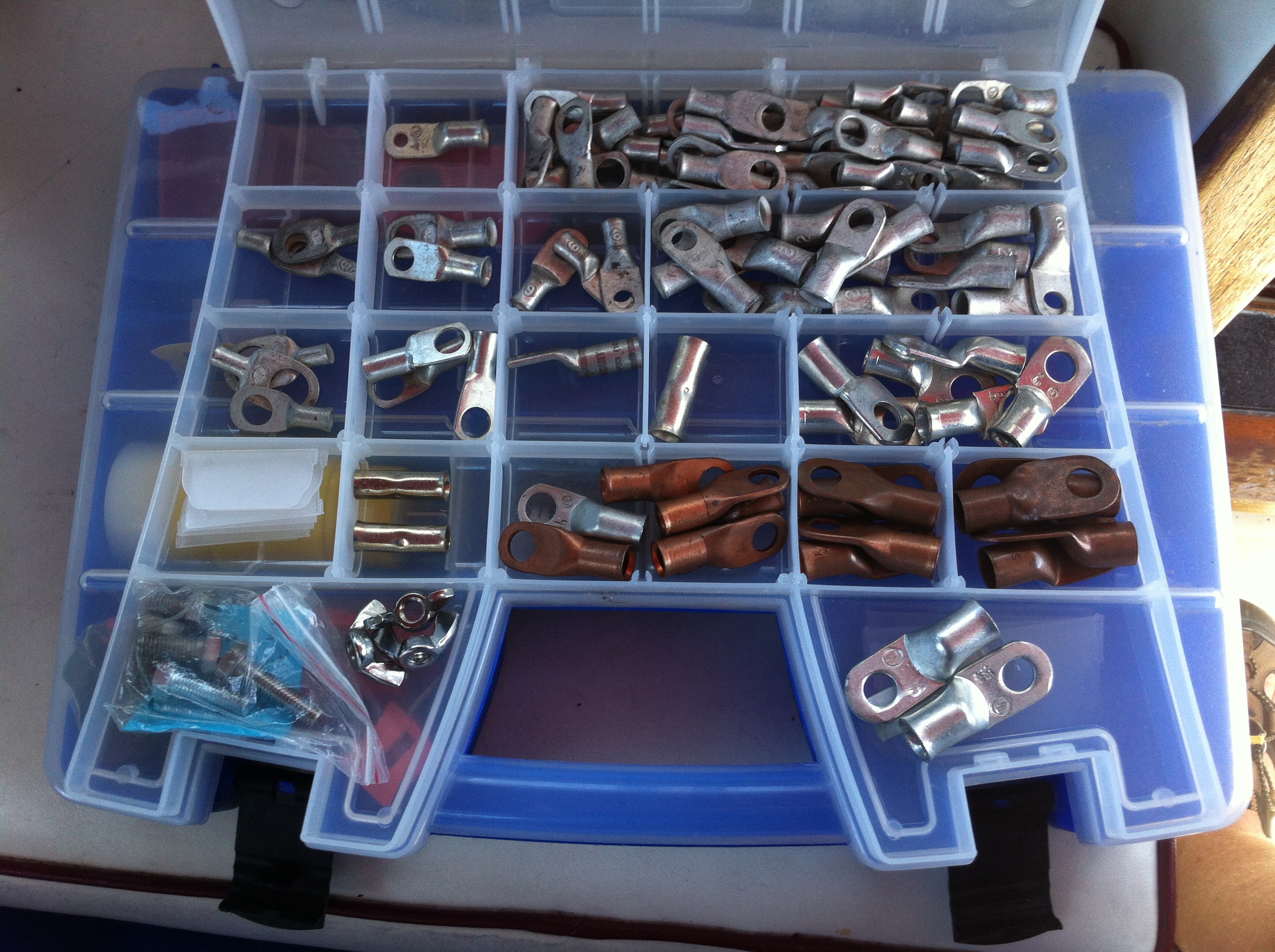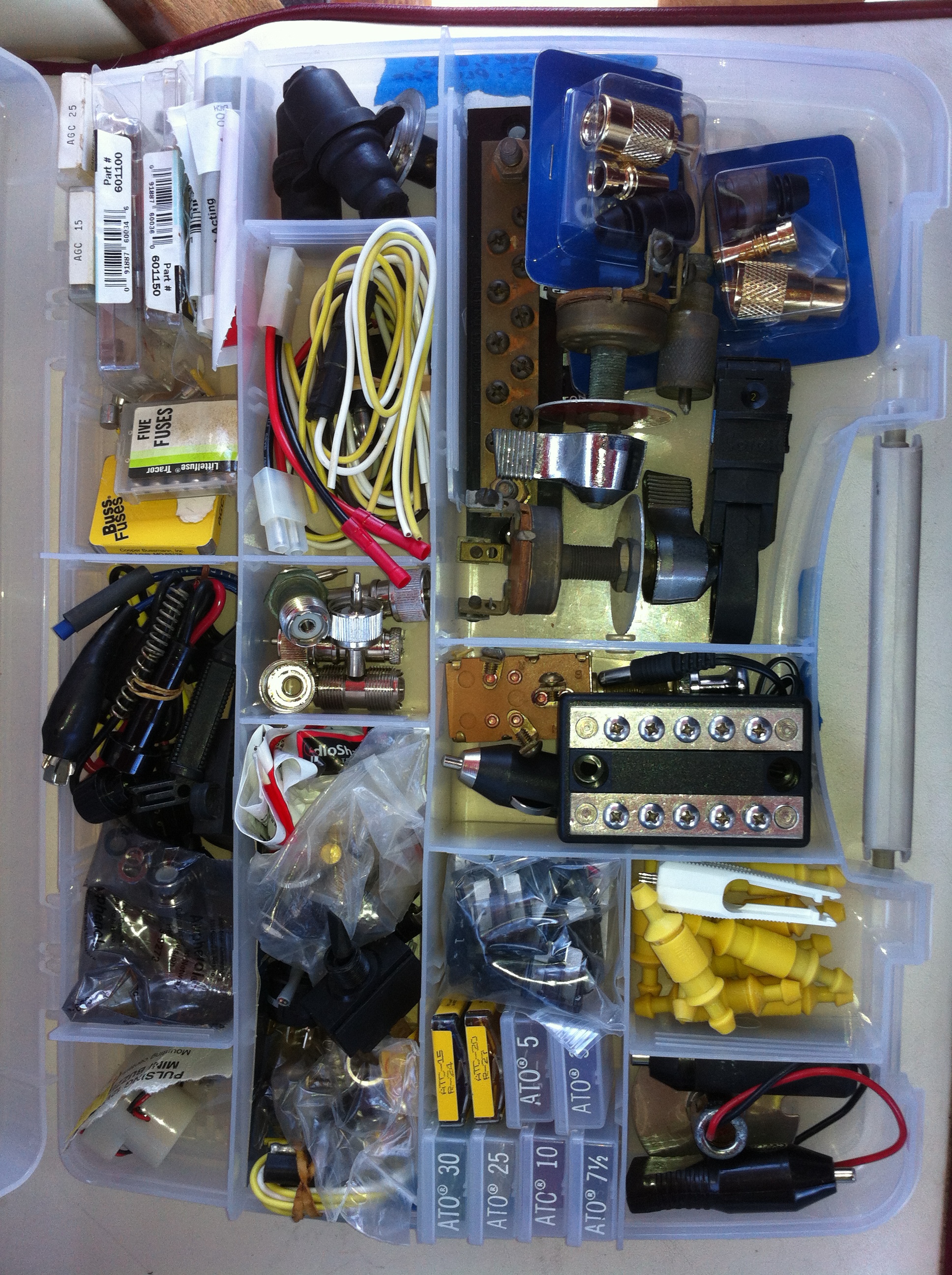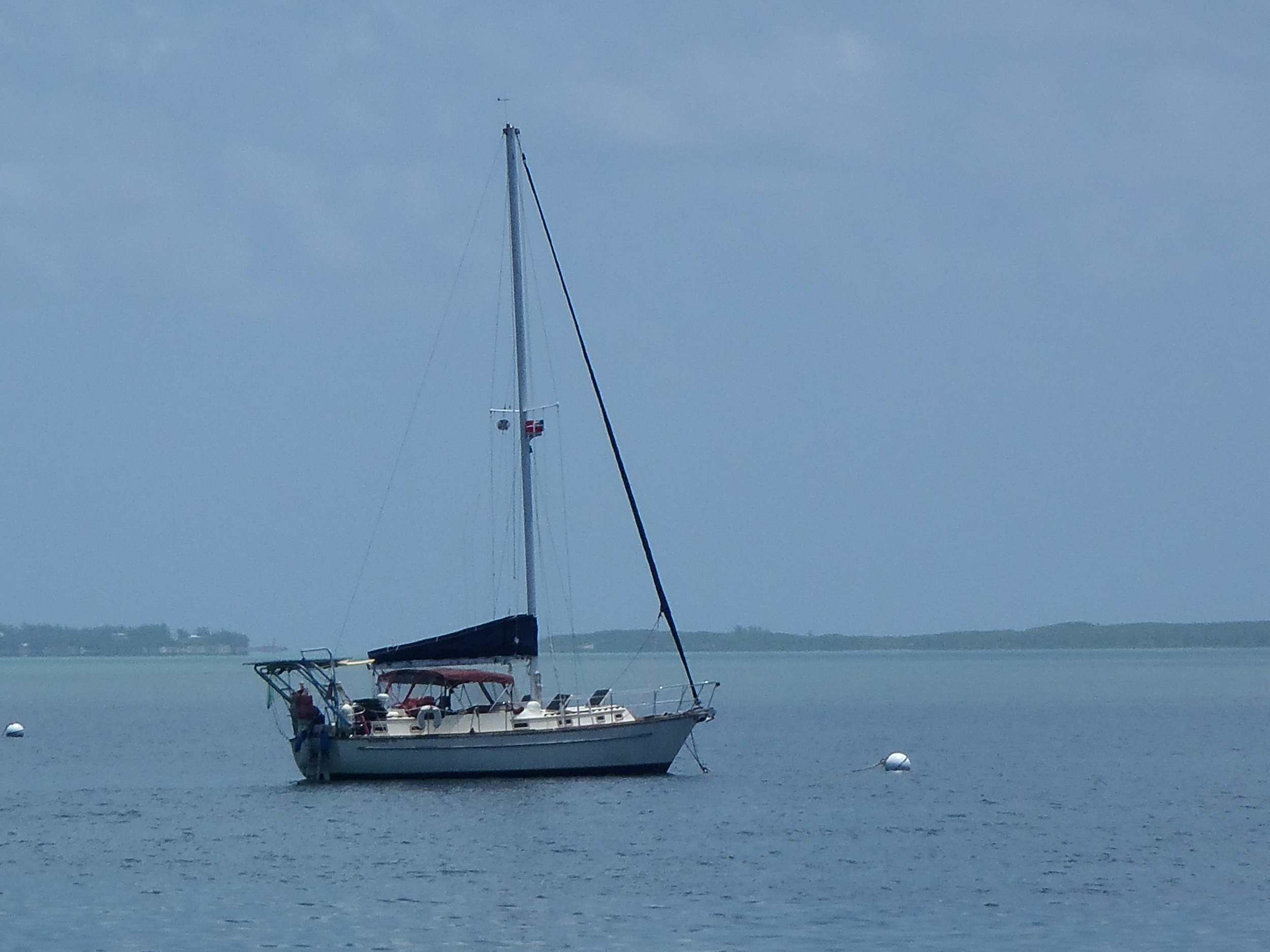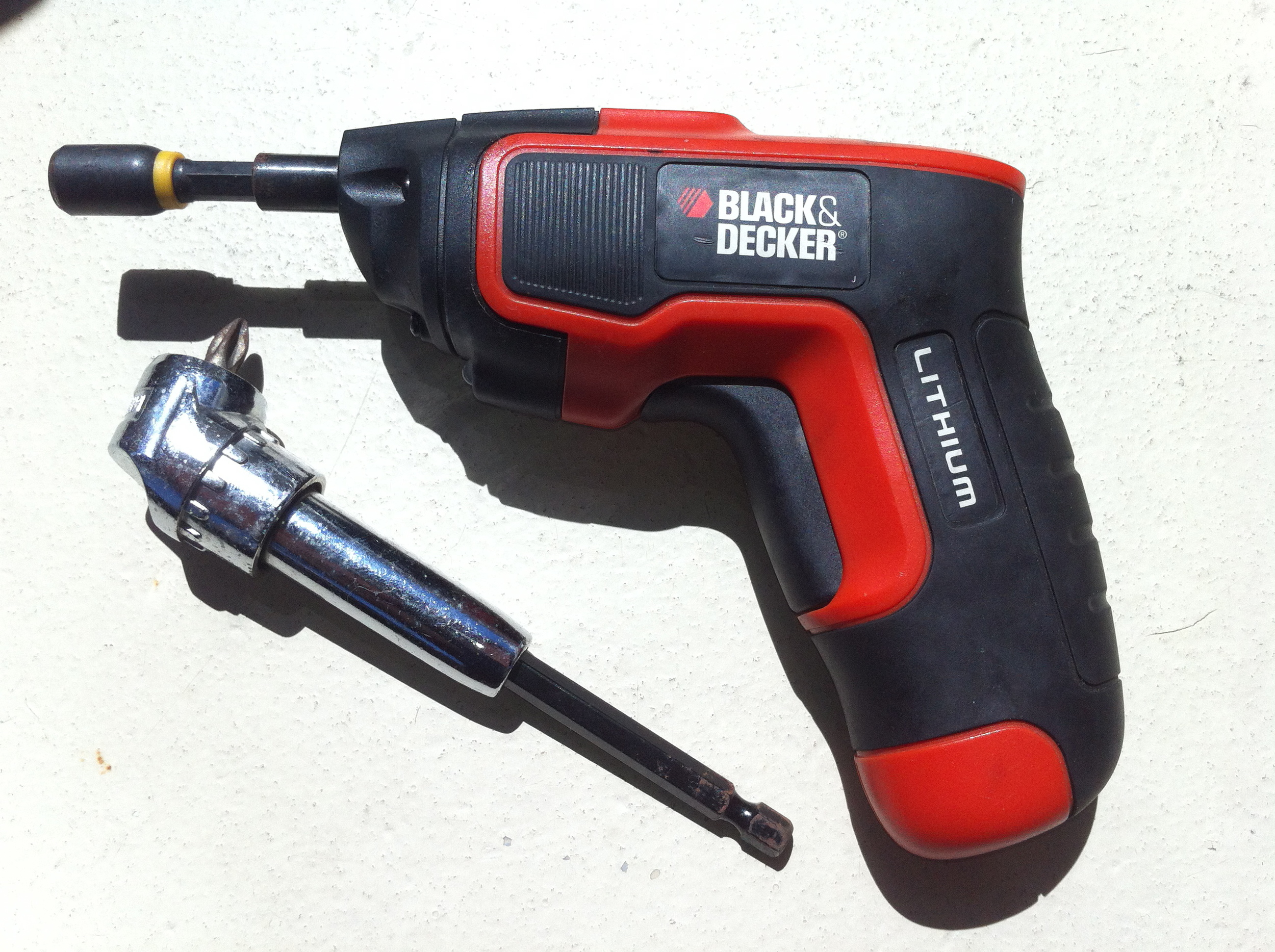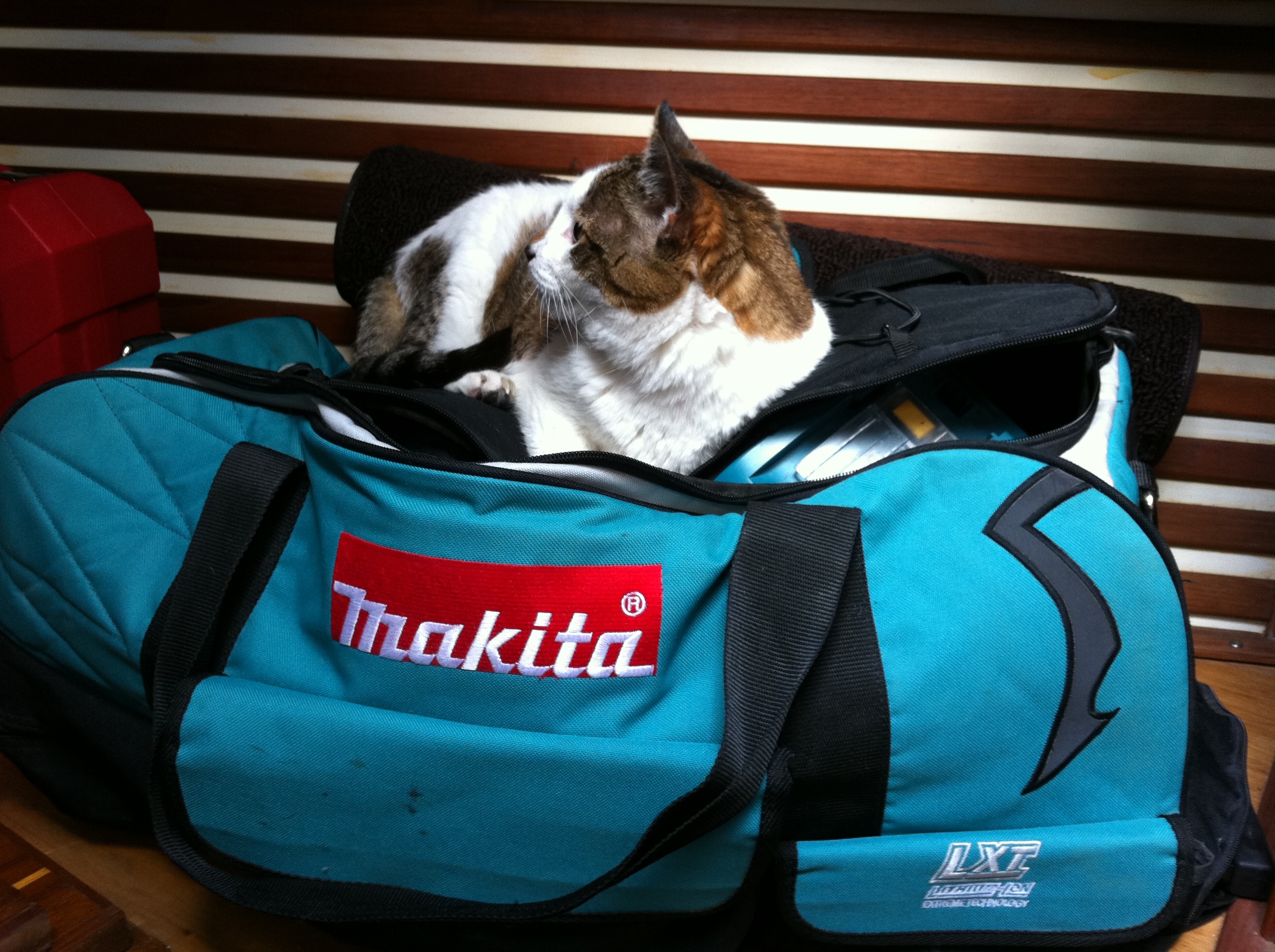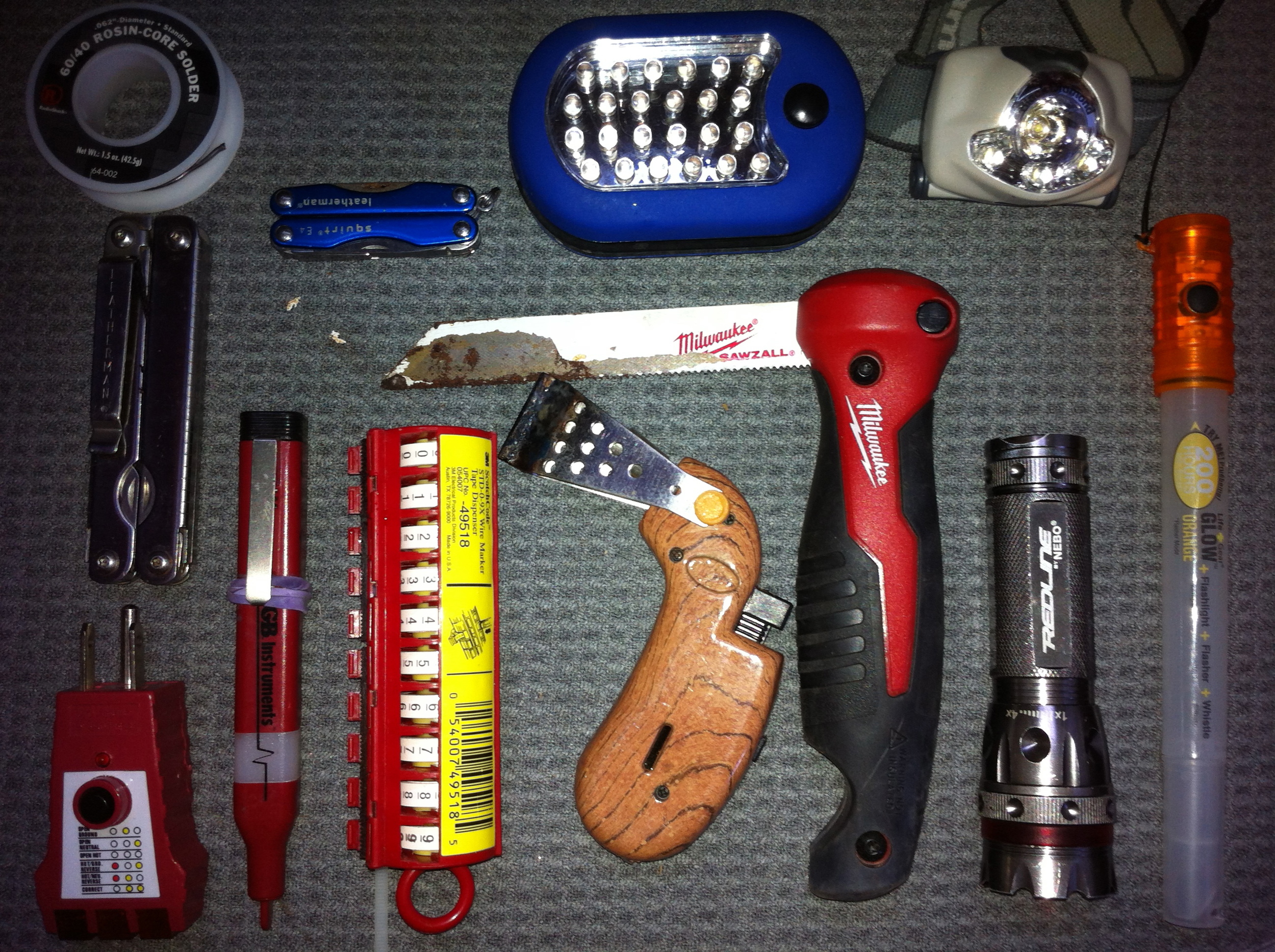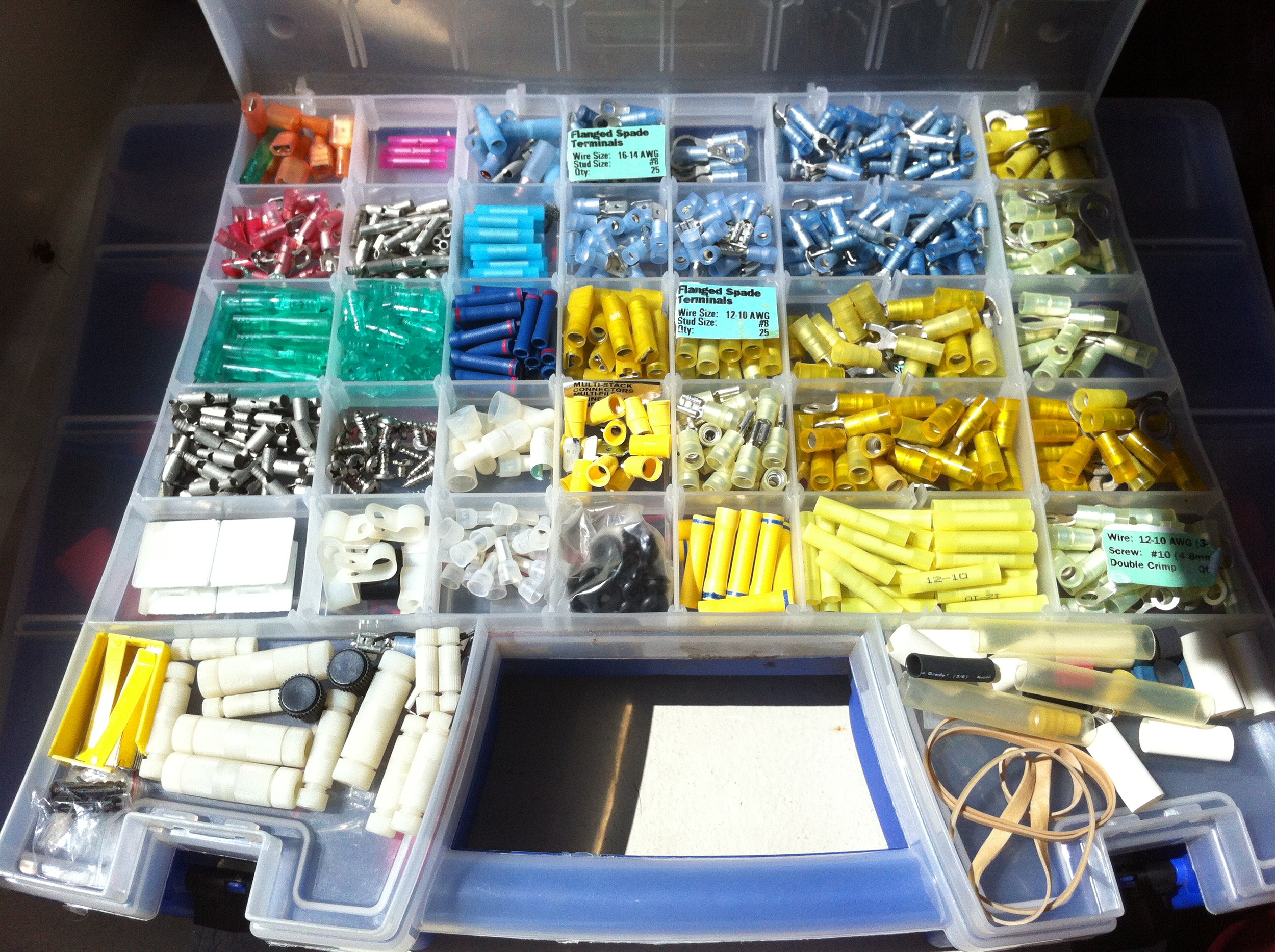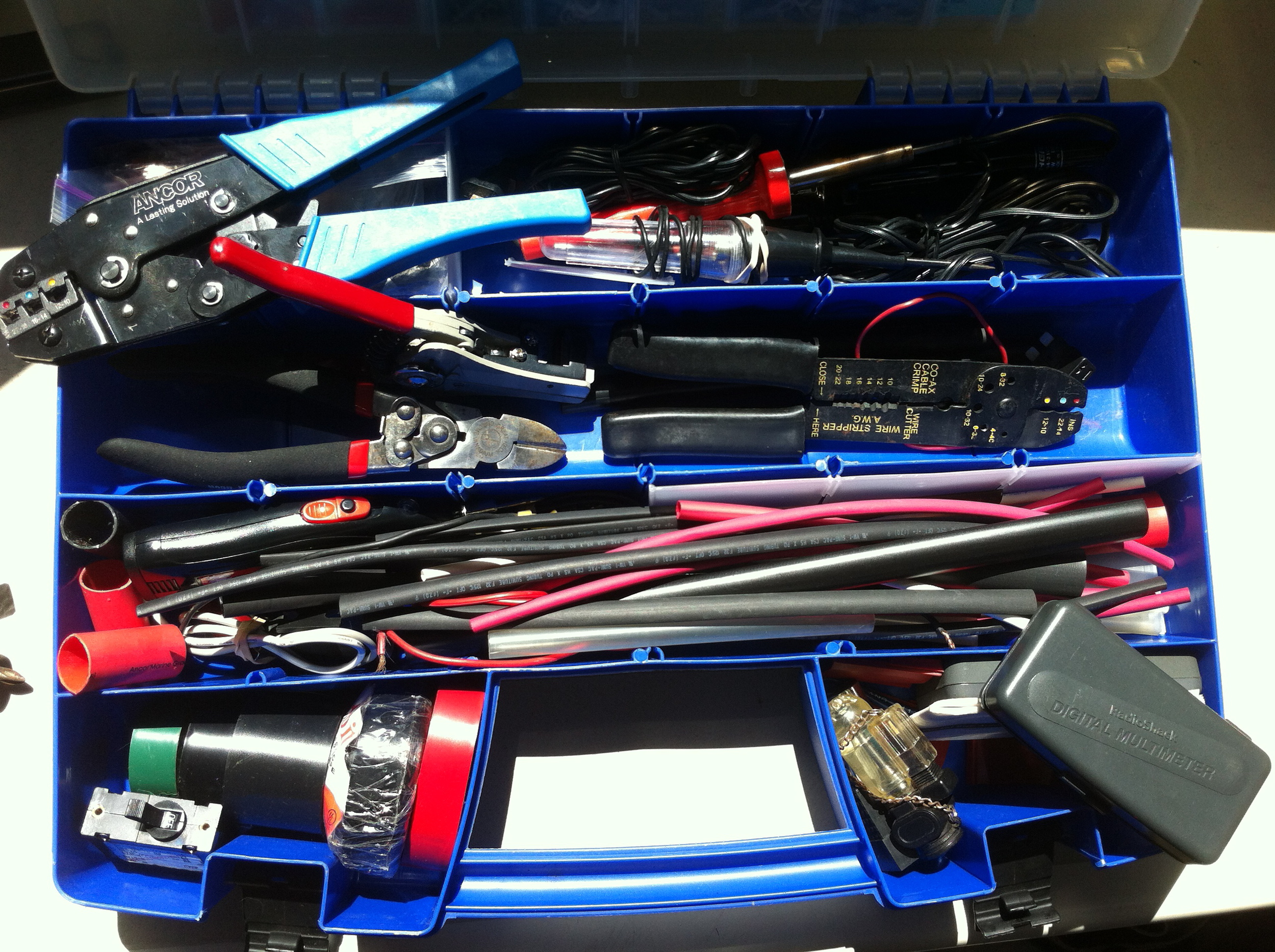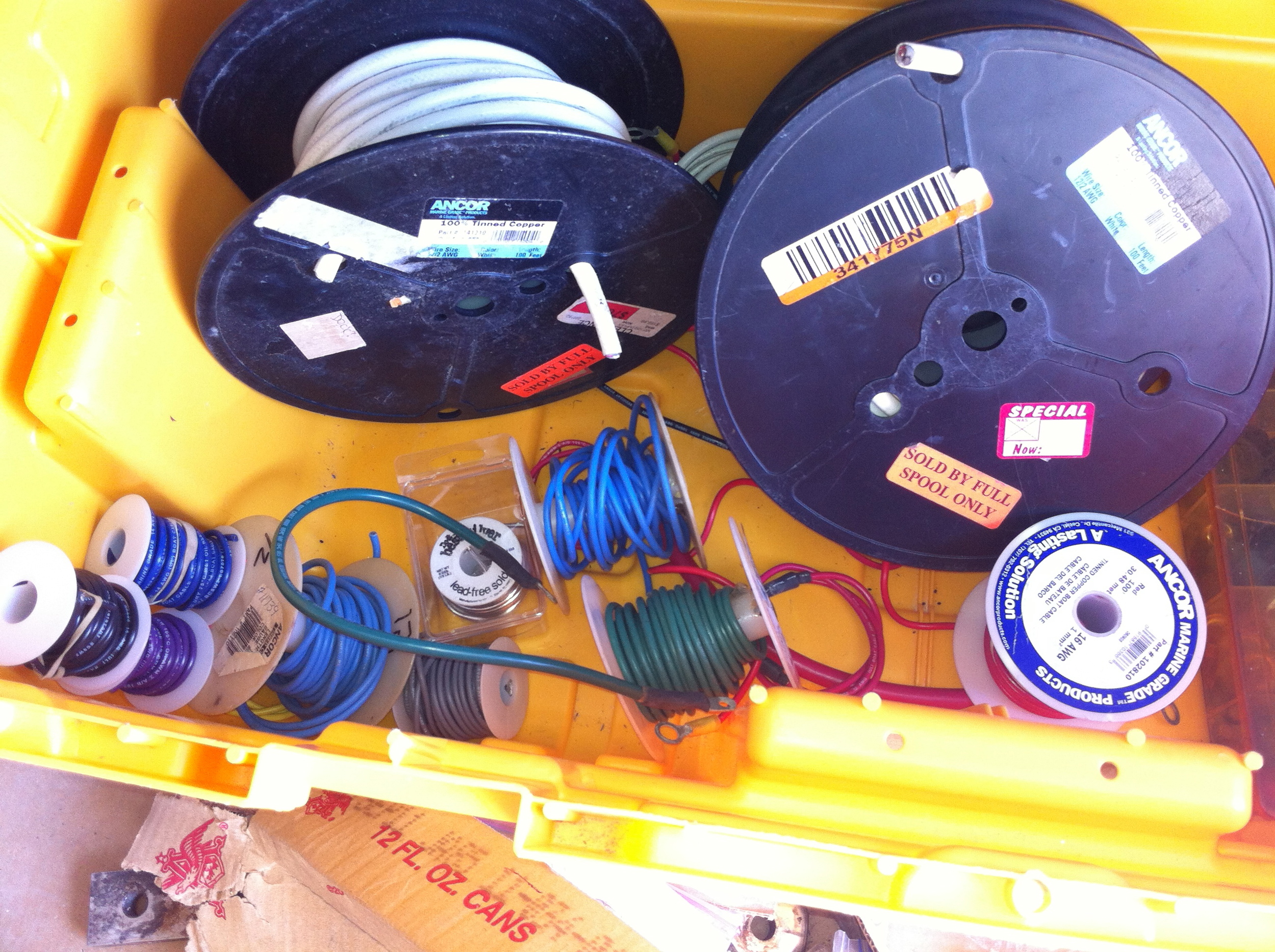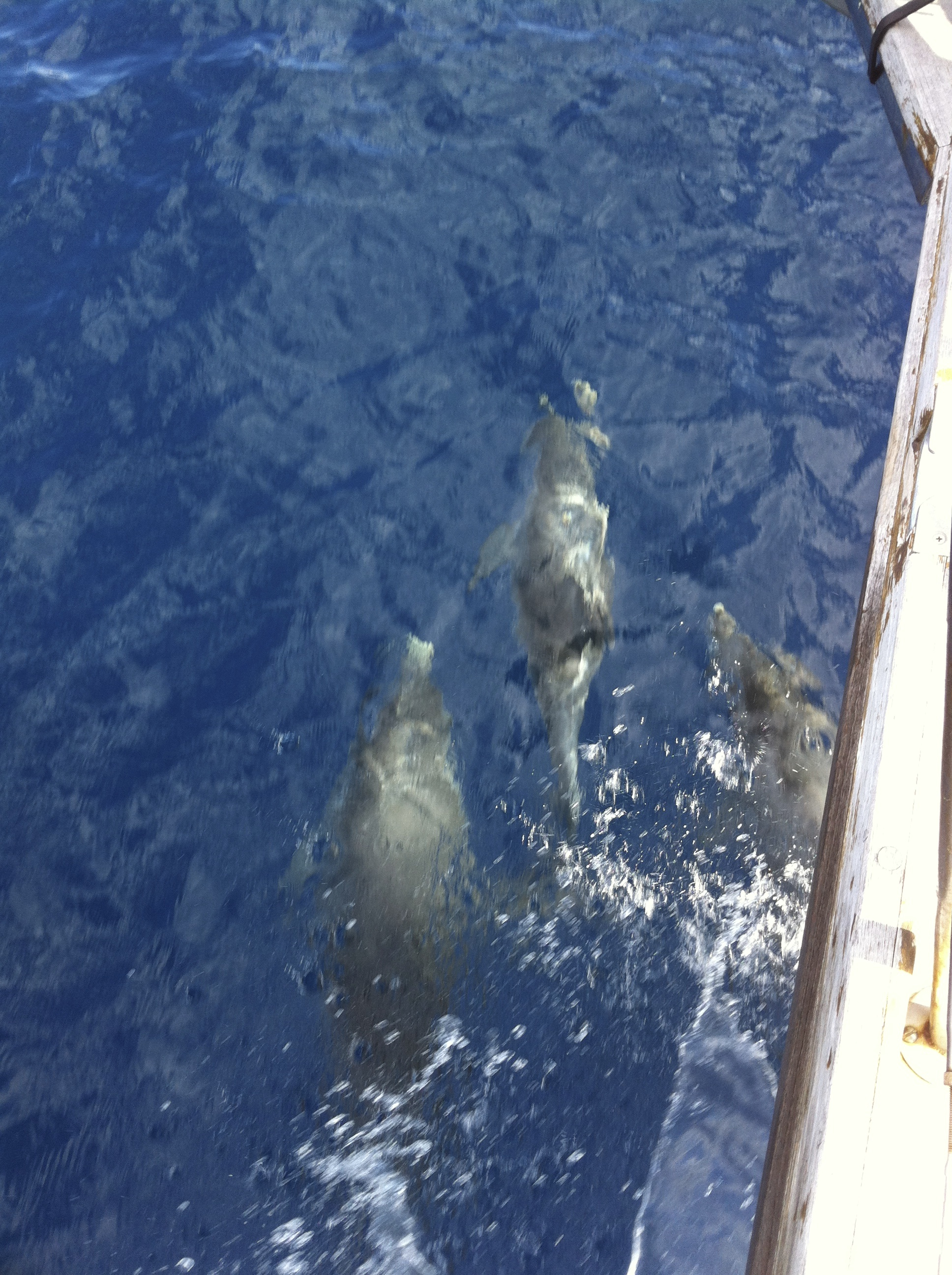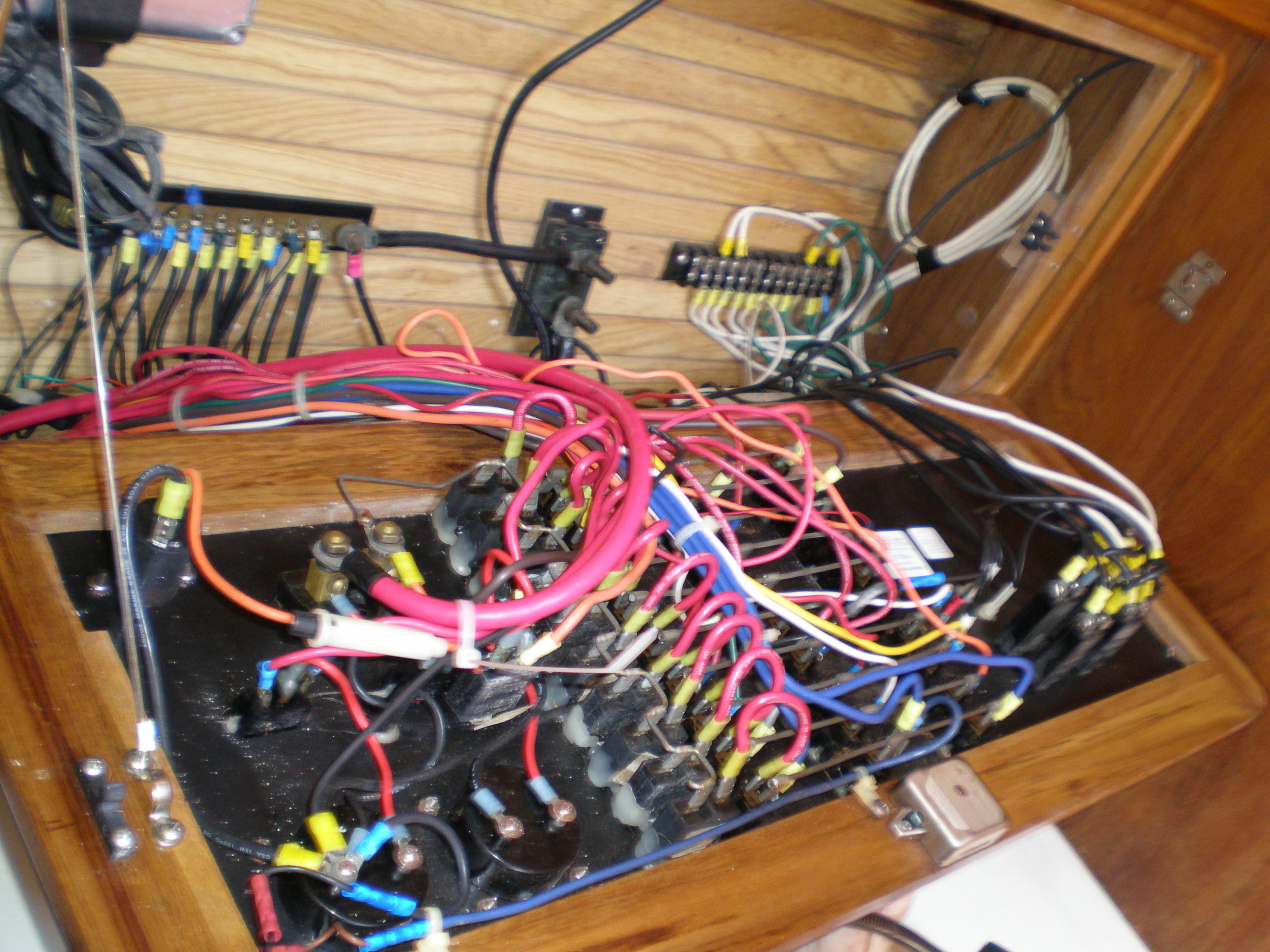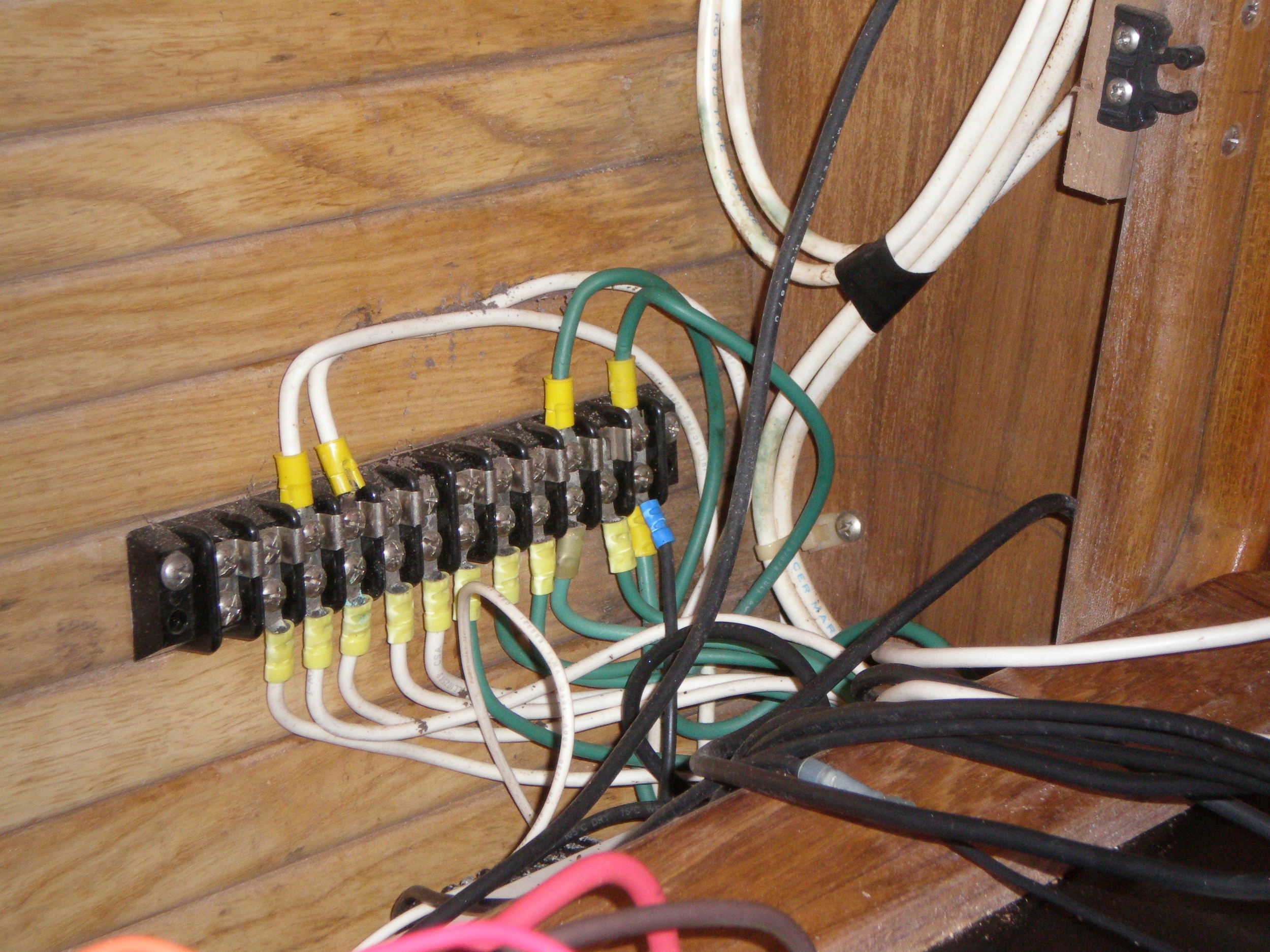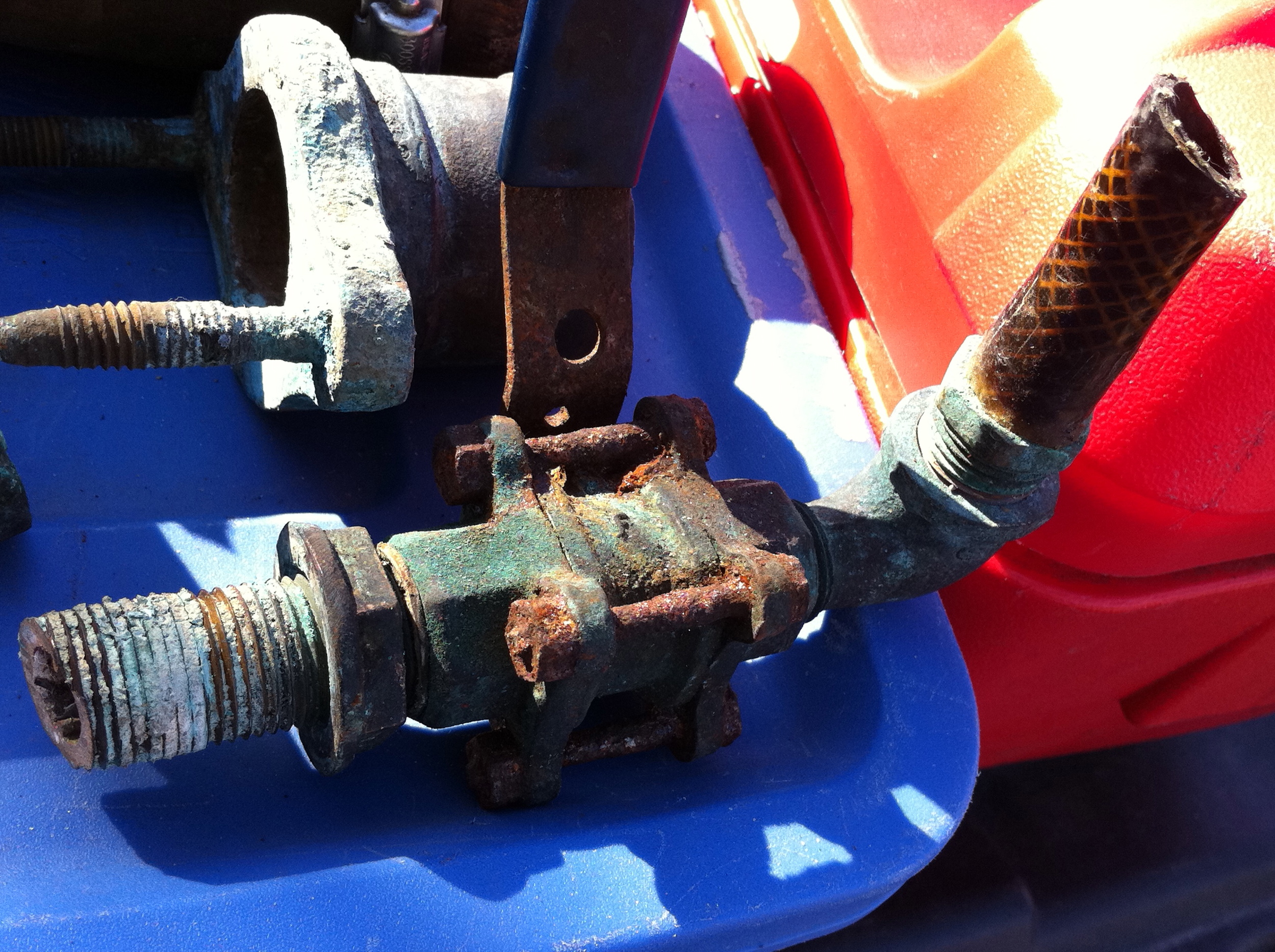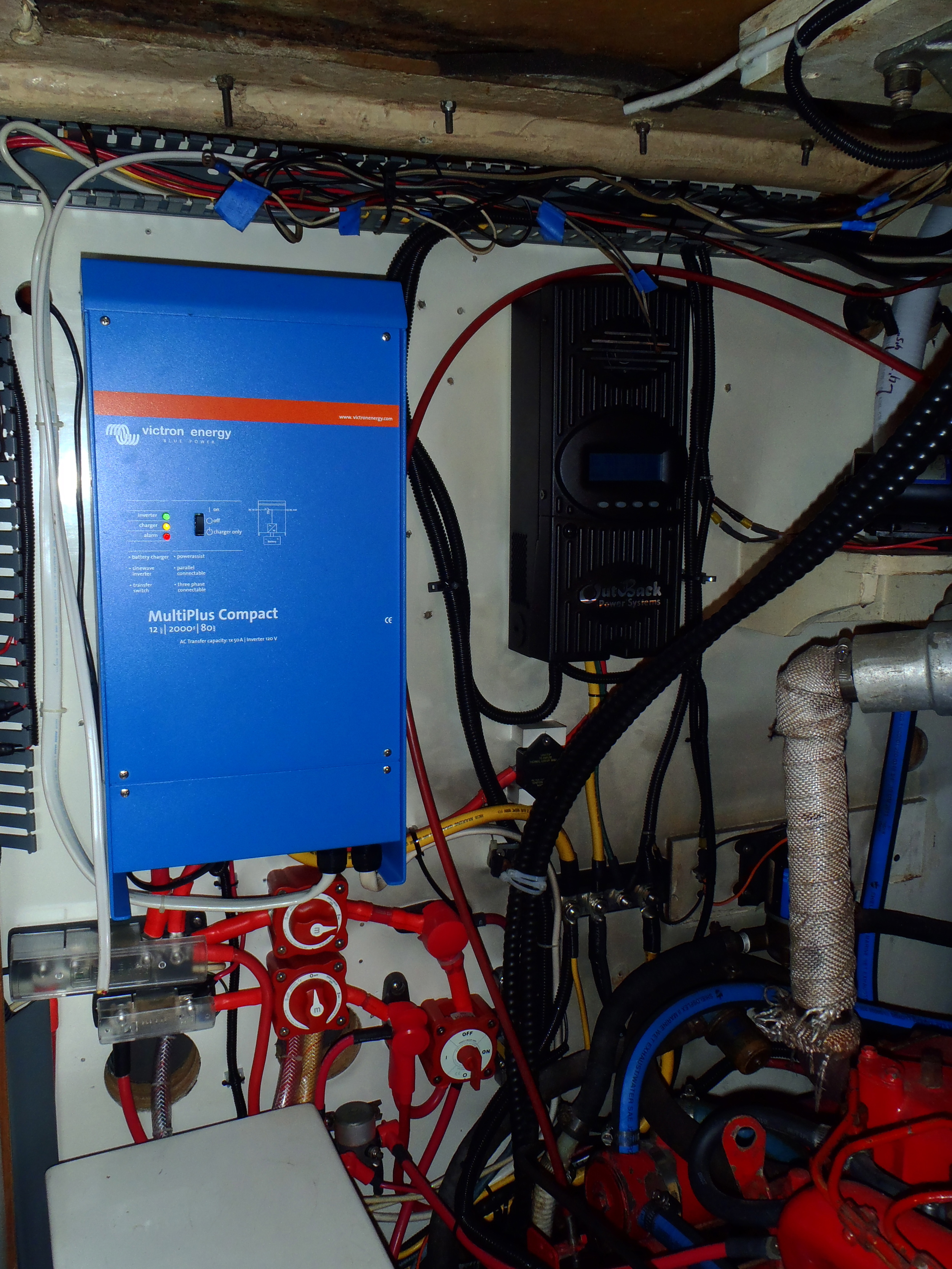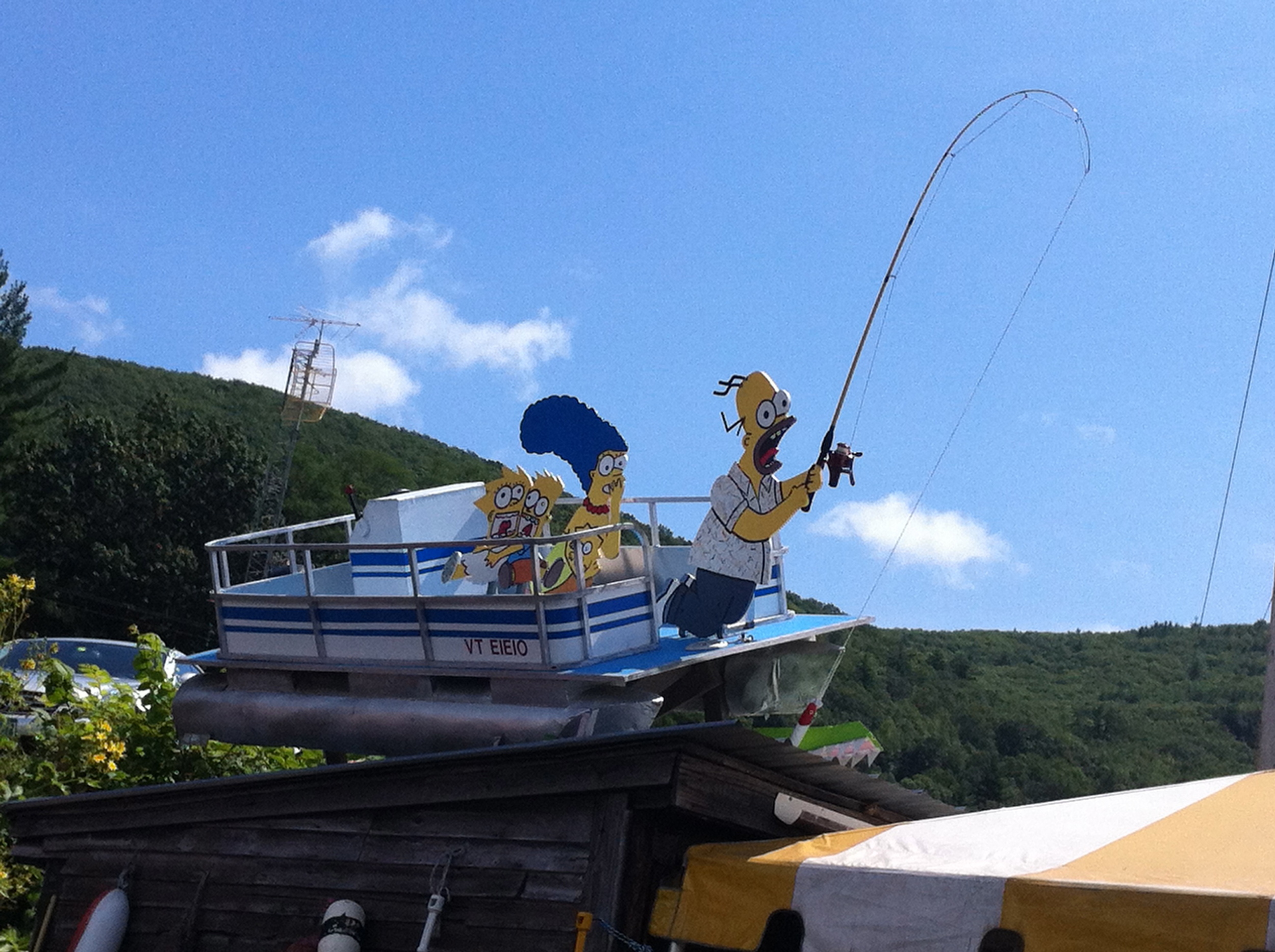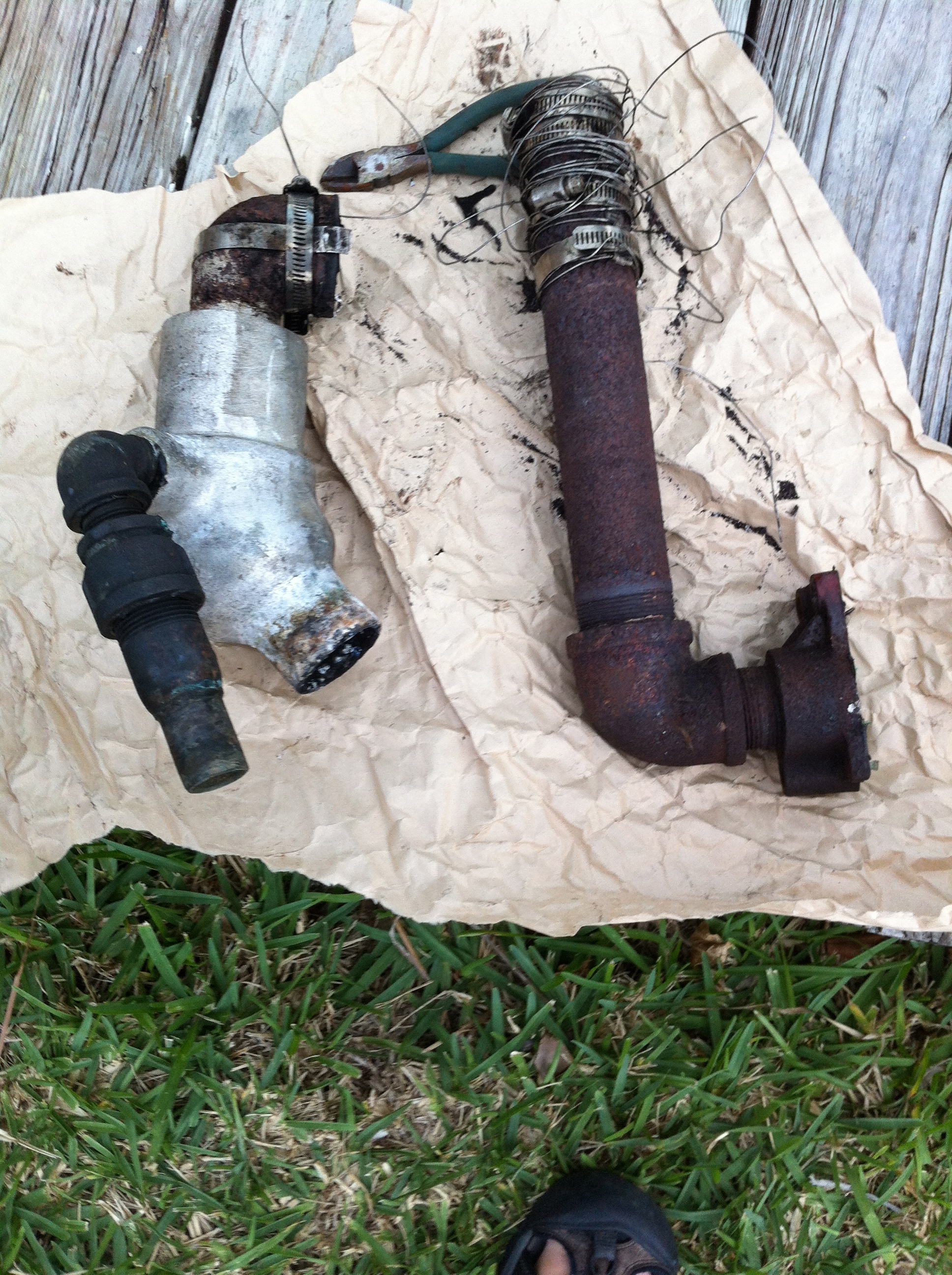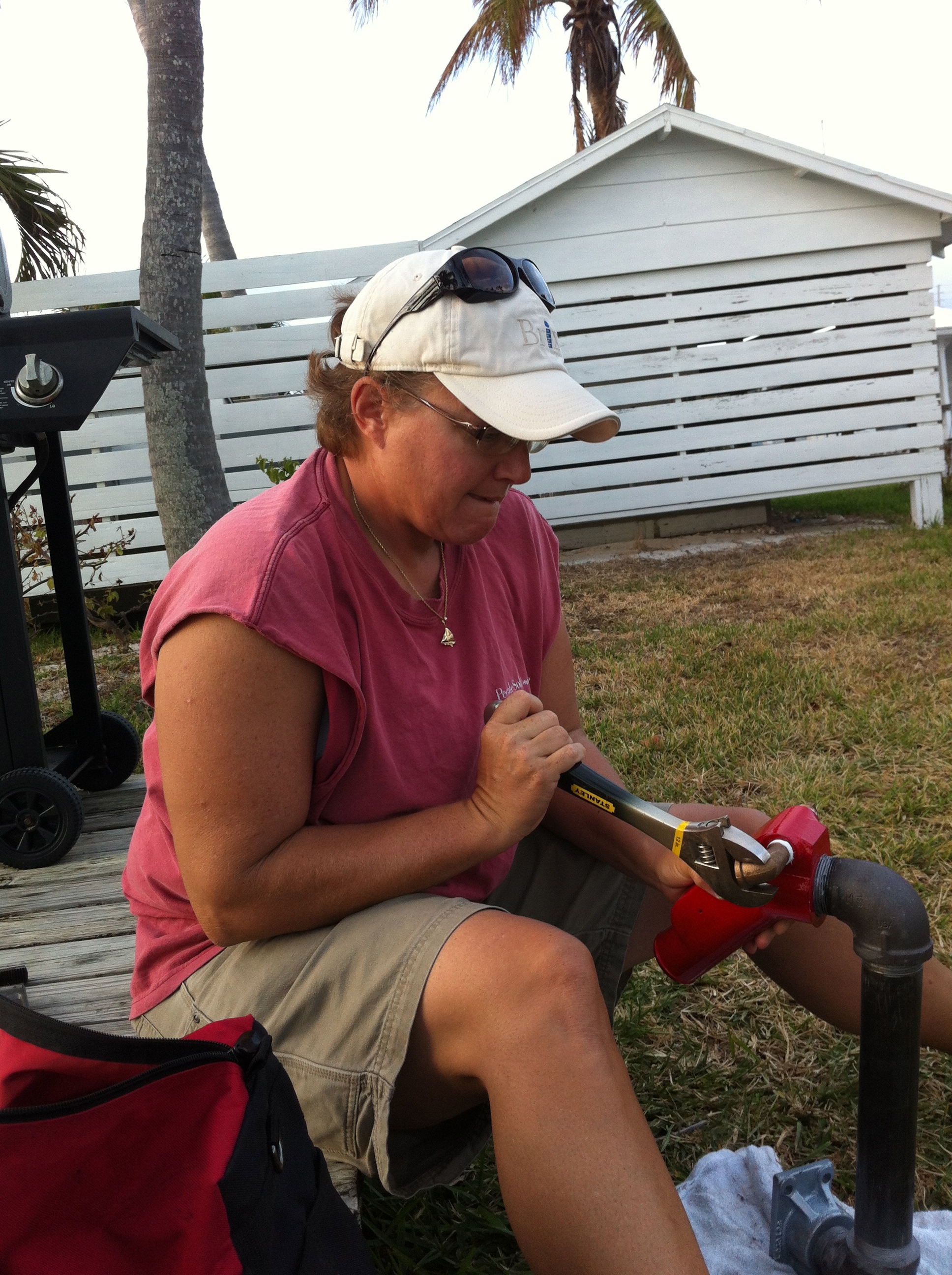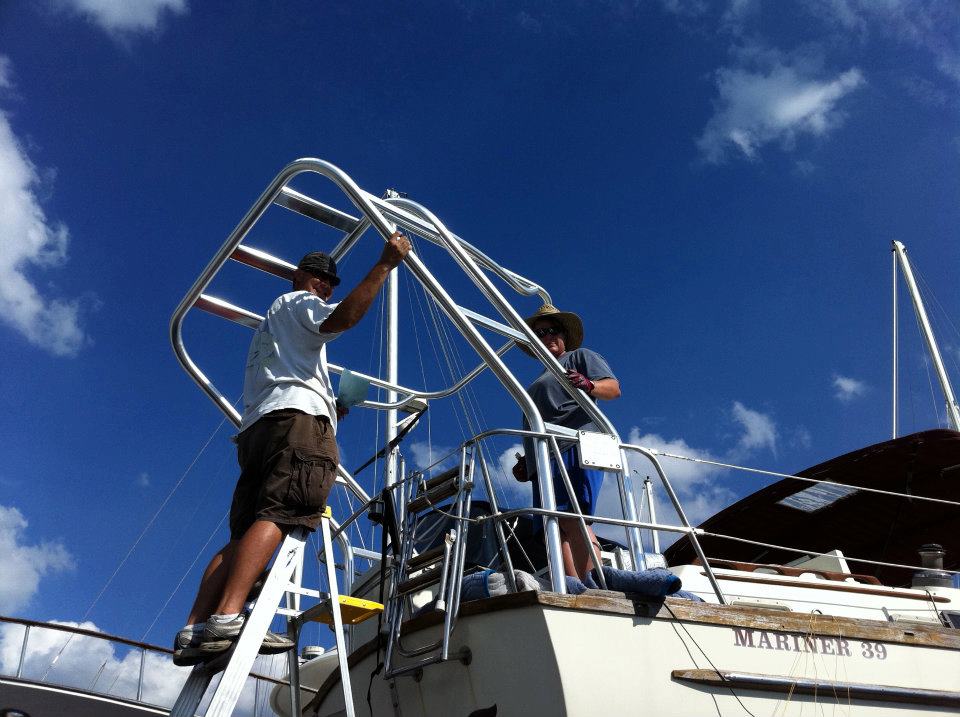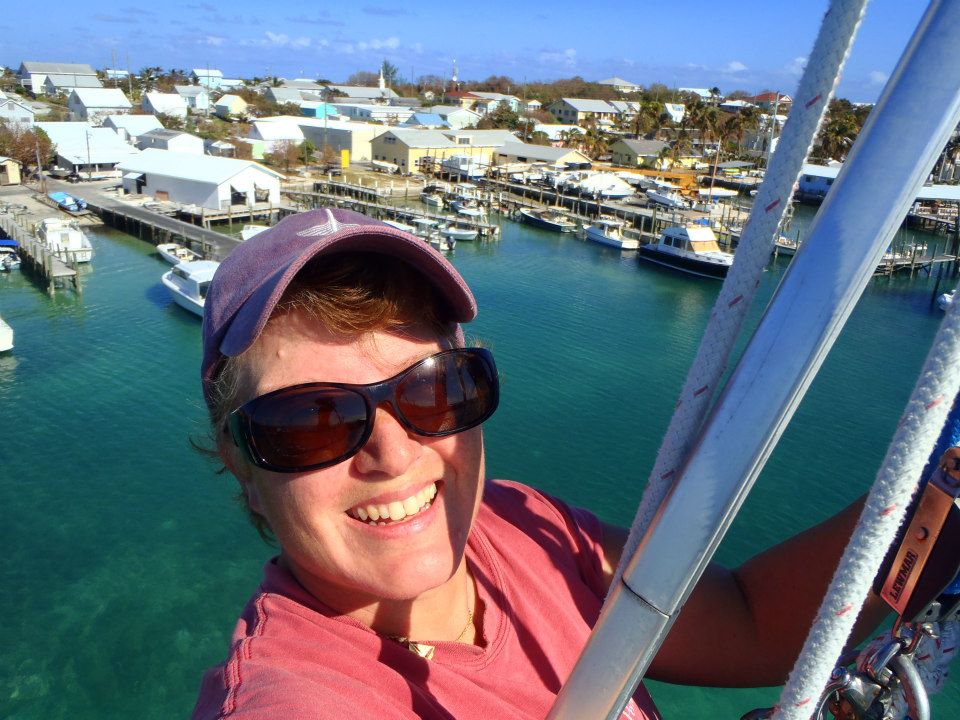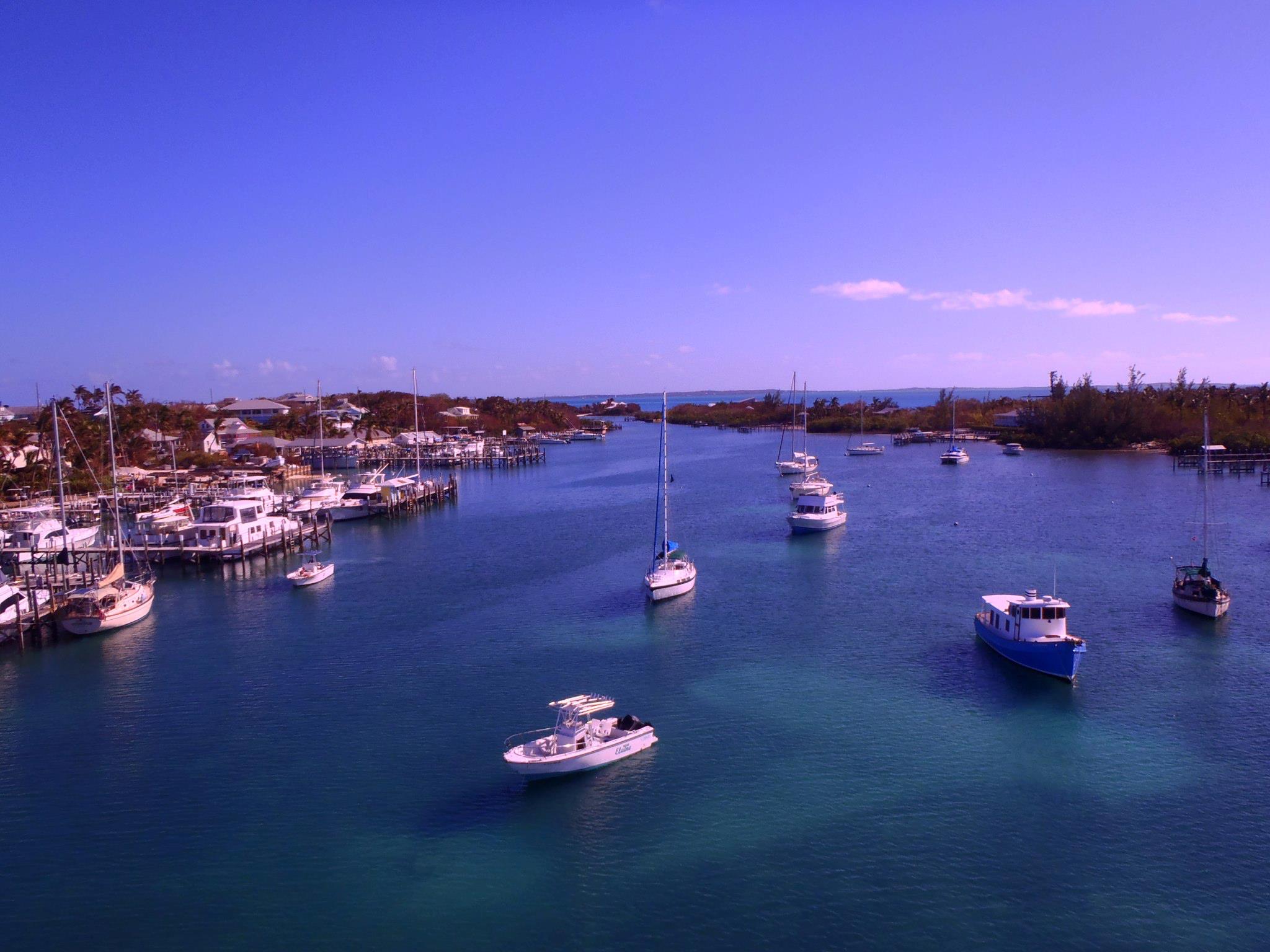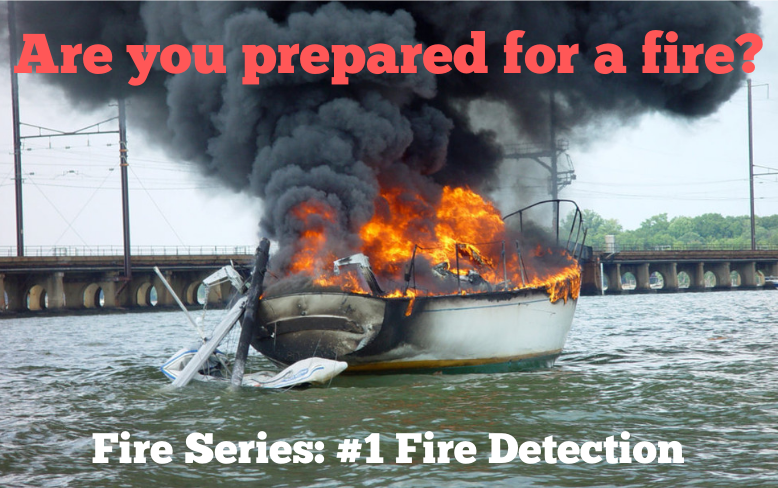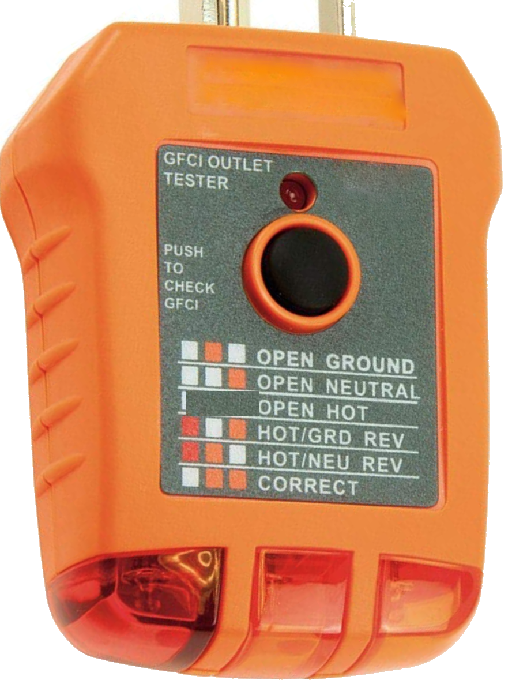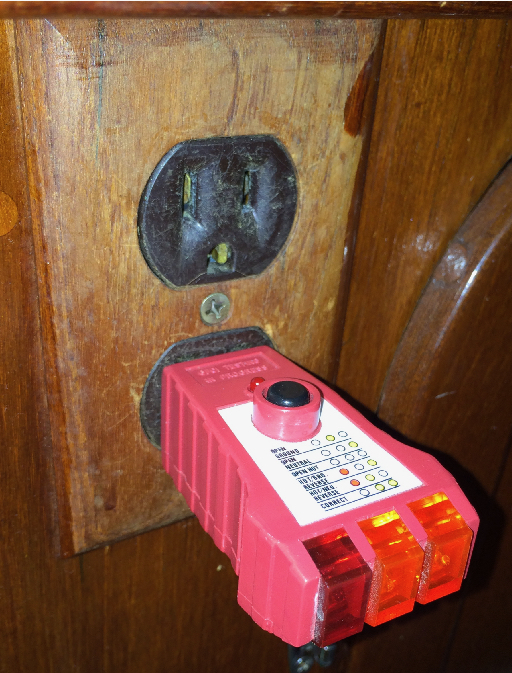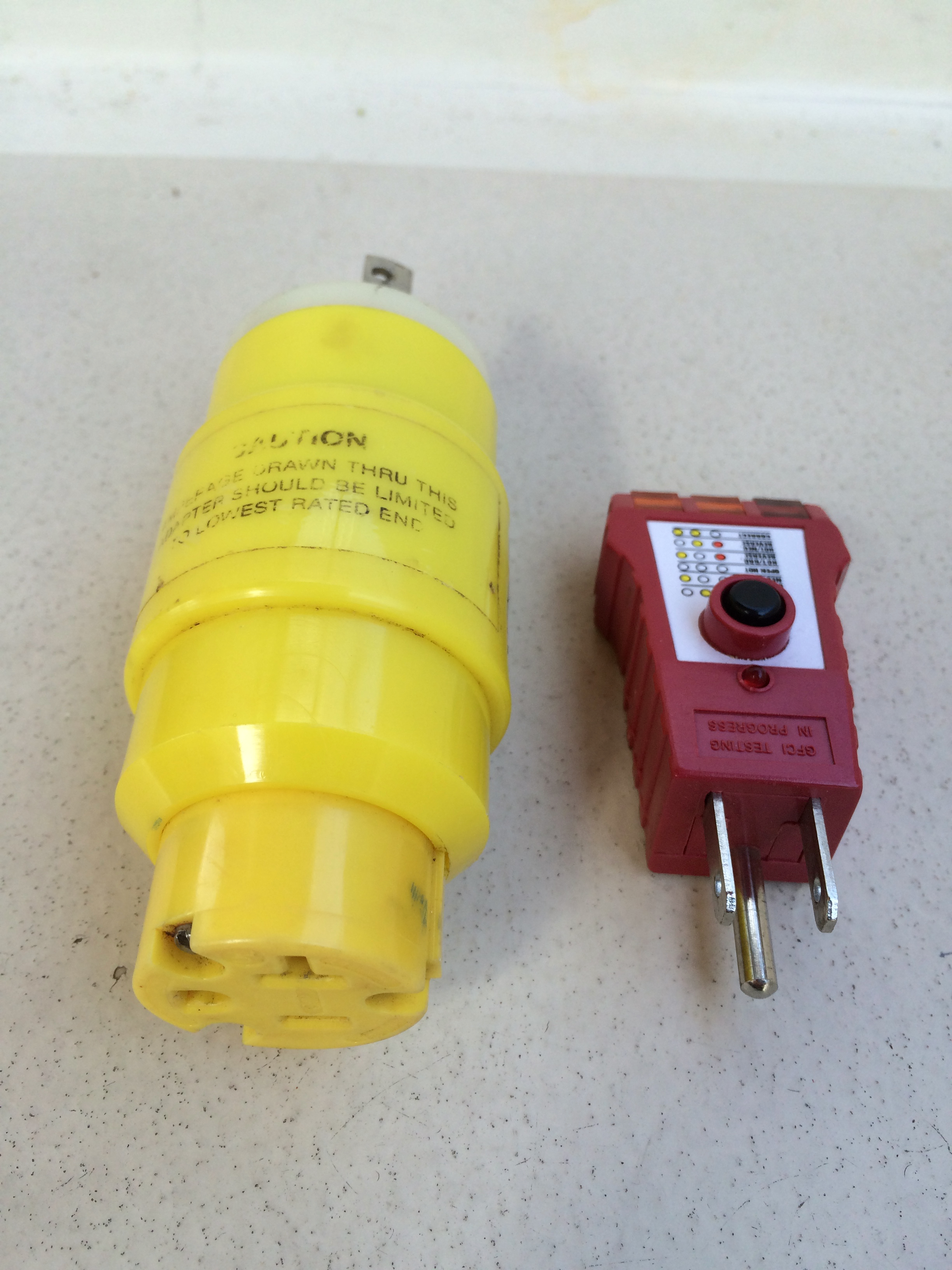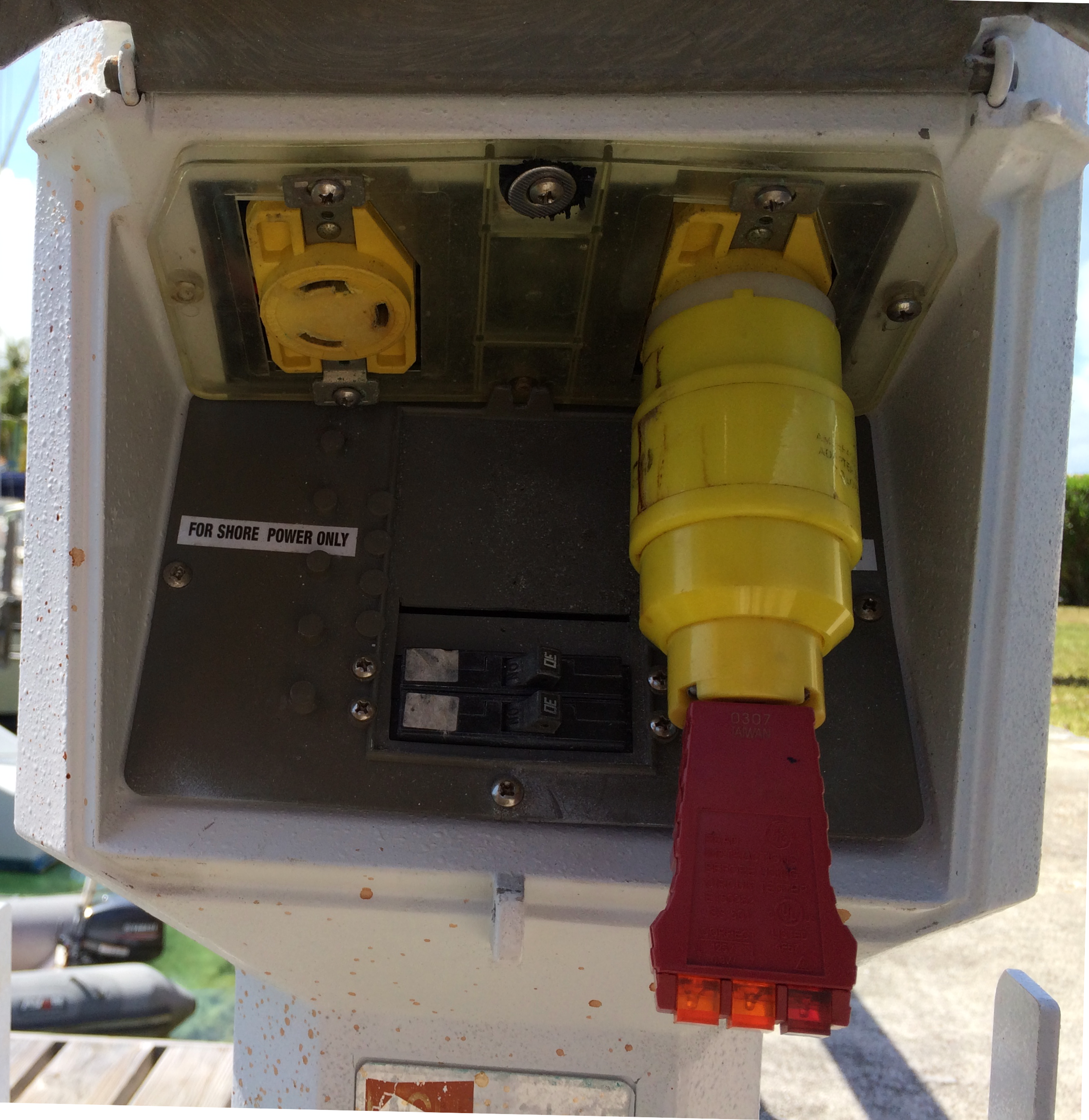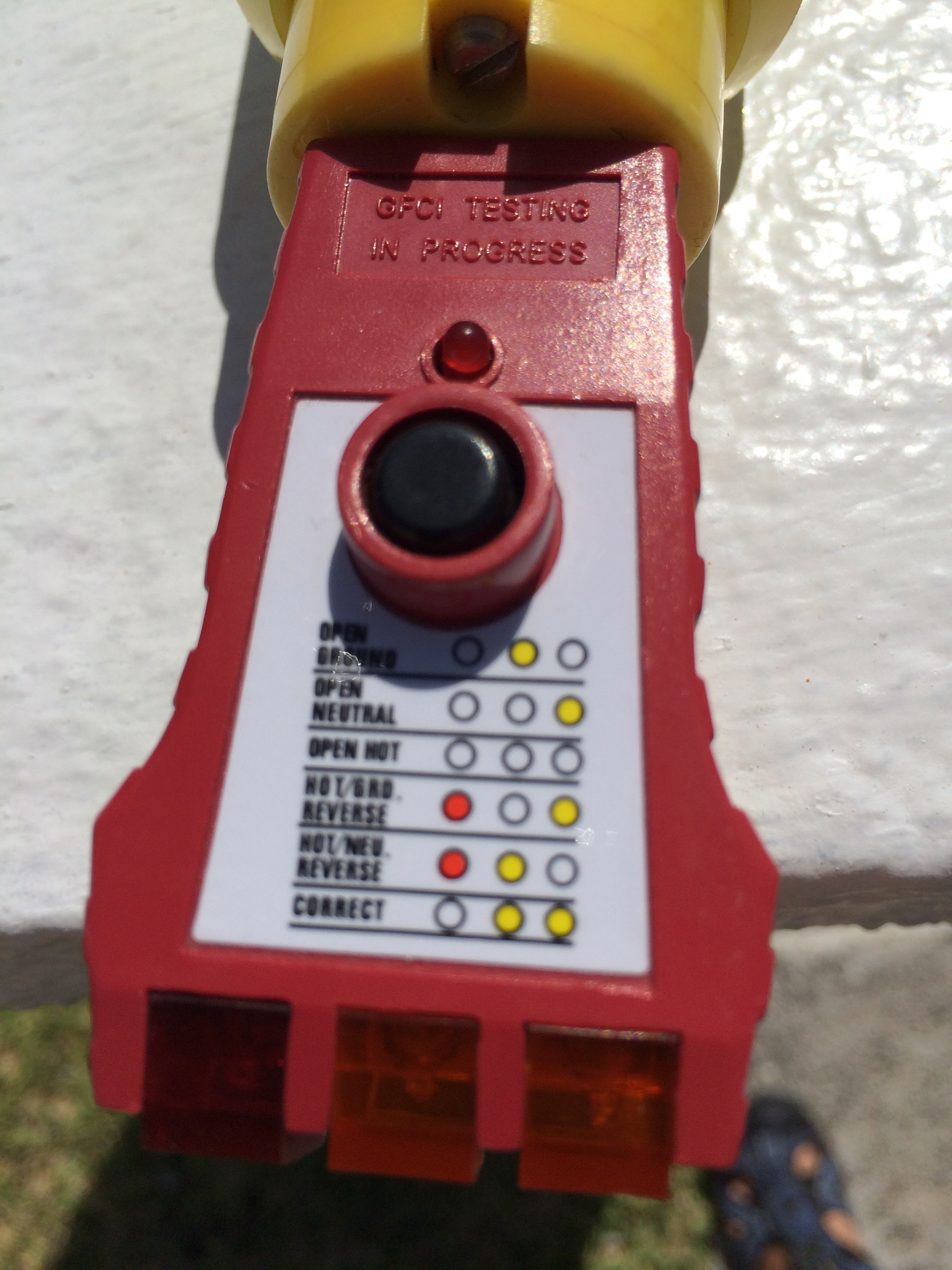Boating, Equipment, and Safety Tips
Do you have a tip or recommendation you’d like to share? Click “here” to email us.
The Introduction to a New Series on Boat Fires:
Up to now, my postings have been one-offs on different topics but I come across a few topics that I’d like to address in a focused series of postings. The first series will be on boat fires.
I was originally just going to post a quick article about Fire Blankets and bio-friendly Fire Aerosol Sprays (inexpensive and expensive), after friends of mine, Doug and Tina, had a fire on their boat. The fire occurred during their shake down cruise in the Exumas this season (as Tina quipped, “consider us shaken”). Doug and Tina were able to quickly suppress the fire using a fire extinguisher, a fire blanket and awesome teamwork. I had mentioned fire blankets to Doug, but it was Tina, the procurement officer, had purchased a fire blanket after reading Boat Galley’s Fire Blanket article. Below are photos of Doug and Tina water heater (source of the fire), scorched ceiling and just slightly darkened Fire Blanket:
Two months earlier, another sailboat off of Stocking Island burned for a total loss, two boats caught fire in/near West Palm in May, a sailboat in St. Pete, FL burned in June, a Hyatt 40 caught fire for a total loss here at the work yard, the sailboat in the slip next us had a small fire in the cockpit while I was writing this series, and that’s only the fires I’ve heard about.
What caught my attention in these fires, Facebook comments, and articles about boat fires was: 1) very few US boaters know about Fire Blankets, despite Boat Galley’s informative Fire Blanket article, 2) many boats had no or non-working fire/smoke and CO detectors, 3) and most boaters only had the USCG minimum required fire extinguishers on board, while at the same time having never operated a fire extinguisher. So instead of a single article, I’m writing a series of articles/posts covering:
Fire Detection
Fire Suppression
Fire Prevention
Fire Preparedness
Before I start, let me state for the record that I am not a fireman or trained fire expert, and I am not going to re-iterate the wealth of superb articles already written on this topic. The postings in this series will highlight key points of discussion in areas that have and have not been covered in various fire articles. And the posts will include links to excellent fire related articles written by Beth Leanard, Charles Fort, Frank Lanier, BoatUS.org, Boat Galley,How To Marine, and more.
The good news is that most boaters should never experience a fire and the bad news is that three in four Americans have never used a fire extinguisher. Continuing with the bad news, fiberglass boats especially their interior are flammable and produce plumes of blinding, toxic smoke that builds near the ceiling and can quickly fill the interior. Combine this with most boats having very confined cabin spaces with few usable exits and a fires that can double in size every 30 seconds. I’m not trying to be dramatic, but I've been in 10+ fires and put out 9 of them. I have done a lot of crawling on the floor because in a house or building fire, that’s the only place to breathe and see where you are crawling to.
During a fire emergency, my first priority is getting everyone safely out of the boat which is not an easy task at night or when the boat is filled with smoke. To support this priority, all sleeping cabins have smoke/fire alarms, CO Detectors with digital display (hard to exit when you’re not conscious), fire extinguisher (to assist with your exit), headlamp/flashlights (for night exits), and we’ll soon be adding fire escape masks (for seeing and breathing) to replace the current assortment of dive masks, swim goggles, respirators w/appropriate, SpareAirs, etc.. More on this in the next post.
As with any emergency, especially fire, the very first action is to notify everyone onboard that there is a situation (FIRE! FIRE! FIRE!).
Sounding the alarm is followed by a very quick assessment and the critical decision of flight or fight. Here are example situations:
a) Fire is out of control, immediately abandon ship (or step to the dock) - sound horn to alert others and call for help
b) Fire has just started, get everyone topside (or on dock) hopefully with ditch bag and then consider options
c) If the source of the fire is obvious and you can keep your back to an exit - can the fire be safely addressed (e.g. galley fire, obvious electrical fire, etc.)?
d) Can fire “fueling” sources be turned off; electricity (except VHF breaker), propane, and engine (if applicable and safe)?
e) Is there time to put out a PAM or MAYDAY, depending on the situation (AKA at anchor, off shore)?
f) If the fire is out, can someone safely (AKA has mask or can breathe) stand watch over it to ensure it doesn’t re-ignite?
g) Has the boat’s fiberglass caught fire, burning fiberglass is toxic and hard to extinguish - abandoning ship!
Again, my first concern is the safety of the people aboard. If you have any doubts about putting the fire out, get out. If you are offshore and have time, hit the VHF DSC and/or broadcast a MAYDAY with your location, situation, and # of people before losing the VHF/SSB. If not, grab your ditch bag(s) and execute your abandon ship plan. Hopefully, your ditch bag has a satellite communication (e.g., InReach, PLB, EPRIB, Spot, Sat. phone). If you are near shore or at a marina, sound a horn, call for help and get to a safe distance.
At the end of this series and especially after reading all the linked articles, would be a good time to write a fire plan that would work for your boat’s layout, your crew, and situation (AKA crossing the ocean, moored/anchored, or stepping onto a dock). This fire plan should dovetail into your abandon ship process (aka stepping on to a dock, dropping the dingy or preparing the life raft) and be used for practicing fire drills that simulating different situations (e.g. galley fire, engine room fire, fire in the circuit breaker panel, outboard fueling/maintenance fire, battery bank fire, and so on).
The next post will be on Fire Detection.
I have read far too many fatal accident reports where the boat had a carbon monoxide (CO) detector but the owner had removed the batteries. Yes, false alarms scare the #%$@ crap out of us. And our first inclination after a false alarm is to pull the batteries out of the detector. BUT our second inclination should be to purchase 1or 2 more carbon monoxide detectors with digital display to confirm if the first CO detector needed to be replaced or if there is a CO problem or even harder to find, an intermittent CO problem (AKA when the generator is running and a specific hatch or port is open).
Why are CO detectors critical! Because CO can drift in and out or collect in dormant areas and the continuous or intermittent exposure to carbon monoxide through your lungs and into in your bloodstream is cumulative over hours or even days. So even if you go out on deck or out for lunch for an hour or two, the carbon monoxide you inhaled is still in your blood. It takes four to six hours in fresh air to exhale about half of the inhaled carbon monoxide in the blood starting from the last time of exposure.
How quickly the CO builds up in the bloodstream depends on how much CO you have been exposed to (AKA parts per million or PPM) and over what duration of time. High concentrated levels of CO or long-term buildup that reach critical levels can cause permanent brain damage or death. A study of 96 CO poisoning victims showed that 12 months after exposure, 25% showed evidence of brain damage. These long-term CO injuries can include apathy, memory loss, inattention, and depression.
So I’m hoping by now that I’ve convinced you of the virtues of having several working CO detector with a digital display (and smoke/fire detector) in every cabin that people sleep in, even if it’s just a nap. And with the digital display showing PPM and Peak PPMs, you’ll be able to know if it’s just a headache or if you’ve been exposed to CO gases.
Sources of carbon monoxide: generators, stoves, heaters, outboards, diesel, emissions from the other boats or generators, jet-skies, etc. According to the CDC, "only use portable generators outside and more than 20 feet away from your home, doors, and windows.”.
The highest risk areas for CO are near/under swim platforms when the engine is running, back drafts, and emissions from the other boats or generators. Read: https://www.boaterexam.com/canada/education/carbonmonoxide-en.aspx and USCG: https://www.uscgboating.org/library/boating-safety-circulars/BSC86.pdf.
If the CO detector alarms, immediately look at the display for current PPM and Peak PPM and then decide:
1. Low (< 100) - bring one or more other CO detectors over to confirm the first. This type of leak may be caused by a small exhaust leak or by something else like battery off-gassing or propane. Please DO NOT ignore the situation by just taking the batteries out of the CO detector. Either replace the CO detector if falsing is CONFIRMED by one or more other CO detectors or find the cause. In all cases, humans and pets should not be exposed or in the area until the issue is corrected.
2. Critical (> 100 PPM) - exit the boat immediately or use a clean air source (scuba tank, a respirator on with the appropriate cartridges).
3. If you are experiencing CO poisoning symptoms - seek immediate medical attention, request pure oxygen over nose and mouth. If severe exposure, ask about pressurized oxygen chamber therapy.
When purchasing CO detectors, ABYC recommends marine carbon monoxide detectors with UL-1524 ratings. These marine models have been heavily tested for the marine environment (humidity, rugged, etc.). The marine CO detectors are available from name-brand companies like Fireboy/Xintex, Safe-T-Alert, and CO Star Marine. But most, if not all of the marine CO detectors that I know of, do not have a digital display and are much more expensive.
I strongly recommend having at least one, if not all, CO detector(s) that are battery operated unit with digital display showing current and peak CO PPM along with indicators for low battery and replace unit. The more common, UL-2034 rated CO Detectors (for RVs/more rugged), found online and in local stores are suitable for recreational boats and many models with digital displays. But note that the UL-2034 rating does not cover low PPM detection and the detection time in my opinion is too slow. Or as described by a post on EnergyVanguard "a UL listed CO alarm would allow you to breathe air with 358 ppm for 45 minutes—with NO alarm at all”. So if you are serious about carbon monoxide safety, you might consider investing in at least one, low PPM detector with faster detection time, like the Defender model ll6070 ($160+/-) that goes beyond the UL-2034 rating. If I don’t purchase a Defender model ll6070, I’m might purchase a low PPM professional detector for tracking down false alarms and for periodic testing:
Forensics’s Car, Vehicle, Aircraft Carbon Monoxide CO Detector with Fast Low-Level 9ppm Alarm; Alarms at >9ppm @ 60 secs, compared to home CO detectors that only alarm >70ppm @ 60-240 minutes.
Here is another good carbon monoxide safety article that is oriented to homes and apartments but still very much on point: https://www.akhomeshow.com/carbon-monoxide-safety.php
I’m not keen on recommending which CO or Fire/Smoke detectors, aside from the Defender listed above, because some non-UL rated Chinese detectors have better customer review ratings than top name brands. But with that said, here is what I have purchased for CO detection: Kidde Battery Operated Carbon Monoxide Alarm with Digital Display (KN-Copp-B-LPM). This Kidde CO detector has good reviews from a large number of reviewers and I can afford to buy 2-3 (one for each cabin) for the cost of a marine CO detector.
I’m also not keen on combined Smoke/Fire and Carbon Monoxide (CO) detectors because I do not believe the placement criteria are the same. For example, the Smoke/Fire detectors should be high, like on the ceiling, since smoke and heat rises. Carbon monoxide is gas with a weight similar to oxygen (AKA it can be anywhere). ABYC does not specify where CO detectors should be mounted. BoatUS.orgsuggests at an eye level so you are often checking digital PPM display and warning light and that every "Sleeping areas, main saloons, an enclosed fly-bridge [or enclosed cockpit], and anywhere else people spend time are candidates for a CO detector. Areas that should be avoided include near hatches or doors where fresh air might distort readings. Dead air spaces-corners-should also be avoided.”. I would add that I don’t breathe off the ceiling, so I'd never put my CO detector on the ceiling. I have been known to sleep with my CO detector on the pillow next to me. This is an extreme example because our previous sailboat’s Atomic-4 gas engine that had an exhaust leak that we discovered during our first shake-down, thanks to our CO detectors. Even after we fixed the leak, I always slept with the CO detector by my head whenever we motored. Hence my love for the Peek CO PPM display assuring me that I was not exposed to CO during my downtime.
For battery-operated Fire/Smoke detectors, you can either go with a more expensive Dual-Sensor Smoke Detectors that combine ionization and photoelectric technology to detect both flaming and smoldering fires like that First Alert Dual-Sensor Smoke and Fire Alarm, Battery Powered, SA320CN.
In the previous Introduction post, I had mentioned purchasing fire escape masks to replace the current assortment of dive mask or swim goggles, full/half-face respirators, or Spare-Airs that I keep in the sleeping cabins for getting out of a boat during a fire and especially if the cabin is full of smoke. These fire masks provide 15 to 60+ minutes of filtration, depending on the model and some can withstand up to 1700°F (927°C) in radiant heat allowing the user to see and breathe during their exit. Non-certified escape masks start are available at Amazon but the better-reviewed escape masks, like FireMask RP60 or the FireMask RPD60 with fire gloves or the certified iEvac cost substantially more. The RP60 is Canadian designed and conforms to ATSM Standard for Air-Purifying Respiratory Protective Smoke Escape Devices but is not US ANSI certified. An ANSI/ISEA:110-2009 certified and more robust mask, like the iEvac.
NOTE: These escape masks filter some toxins (AKA the iEvac filters carbon monoxide, smoke, soot, hydrogen cyanide, chlorine, ammonia, sulfur dioxide, CS, CN, hydrogen sulfide) which is about the same as a full-face respirator with the appropriate filter but they do NOT supply oxygen. Smoke and heat rise, so stay low or below the smoke to see better and potentially find better air. Also, read the instructions; some have tabs on the filters that need to be pulled.
Videos:
AlaskaGranny had an informative video on donning the mask: https://www.youtube.com/watch?v=v1U4464WR6s
Do not do this at home, even AlaskaGrandma read the directions first: https://www.youtube.com/watch?v=nC9-MlH3ki0
iEvac has this product video: https://www.youtube.com/watch?v=268hLGZ2sVk
And finally, CO detectors should be replaced every 5 to 7 years when the CO sensor declines ( and yes, even those claiming a 10-year battery life). To avoid forgetting, you can add reoccurring reminders to your calendar for regularly testing all the smoke/fire CO detectors, replace batteries annually or as specified by the manufacturer and to replacing CO detectors after 5 years.
The next post will be on Fire Suppression and will include the benefits Fire Blankets and Fire Aerosol Suppression in addition to USCG required fire extinguishers.
Tip of the month:
Test Your Shore Power - BEFORE you plug-in!
Here is a quick test the might save some heartache.
Why: It is way too easy to have significant electrical damage from plugging to shore power that is incorrectly wired, especially in other countries where electrical configuration might be different than your boat’s or your expectation. A catamaran owner told me he had $30k in electrical damage from plugging into an incorrectly wired marina shore power pole. I have seen my share of shore power receptacles missing ground or having incorrect neutral.
What’s needed for testing: items you might already have, an in inexpensive AC receptacle/outlet tester ($5-$18) and a shore plug to standard Edison plug adapter ($25-$50). For example, we use a 30 Amp 125V Locking Dock Side/Male Plug to 15 Amp 125V Straight Blade Female Connector.
What is an AC receptacle/outlet tester with ground fault circuit interruption (GFCI): an inexpensive test device that detects the most common wiring problems in AC standard and GFCI receptacles. Specifically, the outlet tester detects the following wiring faults: open ground, open neutral, open hot, hot/ground reverse, and hot/neutral reverse plus the GFCI button can test GFCI outlets or GFCI circuit breakers. When purchasing an outlet tester with a ground fault circuit interruption (GFCI) test, I recommend spending the extra $5-10 to purchasing a top name brand (e.g., Klein or Sperry). I have seen inexpensive outlet testers miss neutral errors that the more expensive tester caught.
How does an AC receptacle/outlet tester work: simply plug the outlet tester into each AC outlet and check the outlet tester’s lights in accordance with the instruction for your specific model of tester. In general, if the lights indicate “Correct”, your power is correctly wired. I recommend testing every AC receptacle/outlet on your boat (and/or house) periodically and especially prior to purchase.
How to test the shore power outlet: plug the AC receptacle/outlet tester into the shore plug adapter. Now plug the shore adapter with AC receptacle/outlet tester into the shore power receptacle and check the tester’s lights in accordance with the instruction for your specific model of tester. In general, if the lights indicate “Correct”, your power is correctly wired.
Previous Tips and Tools of the Months:
Non-Contact Infrared Thermometer with laser targeting.
This multi-functional tool can be used for checking the engine, electrical, HVAC, moving components for friction/malfunctions and even the temperature of your coffee. Insure that the thermo gun selected has a wide enough temperature range (-76 to 932 °F or -60 to 500 °C), especially for diesel engine, a quick response time (1 second or less), a distance to spot ratio of at least 10:1 if not 12:1 or great plus an auto shut off. Most units have a Max, Min, and Hold options and the more expensive units have Average and Differential Readings. Optional light or backlit LCD display is also handy to have. Many users recommend a dual lasers help pinpoint the edges of the measurement area. Experts recommend being "careful on distance” to the target does not affect the accuracy of the thermo gun.
Engine diagnostics - for example, our Universal 32hp, the raw water and engine side of heat exchanger should have 30-40% differential and the mixing elbow should be under 200 degrees at any unprotect location.
Mechanical test - anything shouldn’t be hot, like the stuffing box, but why risk burning your finger to find out.
Electrical test - shot the electrical panels and any other electrical connection to find loose (hot) connectors, check cables/cable bundles and electrical components/DC motors that might be hot from low voltage/voltage drop or are malfunctioning.
HVAC test - for those with air conditioners
If you or your kids are in fresh water, do you know about Electric Shock Drowning (ESD)?
If you have not heard of ESD, you are not alone. In the past, a freshwater drowning was considered just that, a drowning. It was not until recent years that more research and communication has been made to distinguish between a drowning and an Electric Shock Drowning (ESD). In fresh water, it only takes 100 mA (1/4 amp) to kill a person within 100 yards of a ground fault leak from a boat, dock or marina. And even less mA to cause paralysis of the muscles (aka inability to swim). Over the recent year, there have been a number of deaths attributed to ESD, many of them children and swimmers attempting to rescue ESD victims. With communication and testing, this is a preventable accident and you can help:
1) Start by reviewing a few of articles and resources listed below on ESD. These resources include tips on prevention and instructions on testing for ground fault leaks.
2) Help get the word out about ESD by talking to other boaters, freshwater dock owners (with shore power), marina owners and especially anyone about to go swimming within 100 yards of a dock, marina or boat with shore power or a generator. Ask freshwater dock owners and marina operators to either test for ESD or post ESD warning signs and prohibit swimming at their facility.
For more information on ESD, read the following articles and resources:
BoatUS's Electric Shock Drowning Resource Center web page
Kevin Ritz article, "A Preventable Dockside Tragedy"
Beth Leonard's article, electric-shock-drowning-explained.asp
Ed Sherman and Chris Dolan's in-depth PDF, Marina Dock Safety and Electric Shock Drowning
Mike Telleria's article on ABYC's site, Does Death Lurk Below
Create a List of electrical items that should be tested annually. For example:
Test the amperage between your alternators and the house and/or starter batteries to ensure the alternator(s) are still outputting the expected amps. An amp meter with an extendable clamp-on makes this task easier.
Check for and clean any corrosion on your electrical connectors. Corrosion can impede voltage that can lead to electrical faults, failures or damaged equipment (i.e., windlass, pumps, motors, and electronics).
Check for and tighten any loose connects, especially battery lugs. Loose electrical connections can cause all kinds of problems ranging from damaging equipment to catching fire. When we are using the infrared thermometer on the engine exhaust, we also shot the thermo last on the electrical switches, connectors and bus bars in the engine rooms to see if any are hot (aka loose connection). See Marine How To’s great article: “Battery Melt Down Narrowly Averted”.
If the house or starter batteries are older, load test the batteries annually or before re-installing the batteries after winter storage to ensure the batteries are still good.
For more recommendations, see the Electrical Tool and Supplies page.
Top Tools To Keep Onboard (my favorite Rolgear drivers)
More tools listed on Boating Electrical Tools and Supplies page
Are smooth and silent (no clicks) ratcheting Screwdrivers or Drivers (4” and 6”)
They are my favorite hand tools, aside from Vice-grips!
“Rolgear is a family owned company in British Columbia, Canada that manufactures and produces a full line of ratcheting screwdrivers. The Swiss founder, Robert Suter, invented the patented technology of his roller type ratchet. Unfound in other ratcheting tools, the Rolgear screwdriver offers single-handed application, including a silent and smooth ratchet with forward, backward and neutral positions.”
You can buy direct from Rolgear (https://www.rolgear.com/) in Canada or from Amazon:
Top Electrical Books To Keep Onboard
If you were to keep only a few marine electrical books on your boat, we’d recommend:
Boatowner’s Mechanical and Electrical Manual, latest edition (ISBN 007009618X) by Nigel Calder
Boatowner’s Illustrated Electrical Handbook, second edition (ISBN: 0071446443) by Charlie Wing
Powerboater's Guide to Electrical Systems: Maintenance, Troubleshooting, and Improvements by Edwin R. Sherman
Boater’s Pocket Reference, latest edition (ISBN: 0977405206) by Thomas McEwen
Top Boat Books To Keep Onboard
If you were to keep only a few marine books onboard, we’d recommend:
Marine Diesel Engines: Maintenance, Troubleshooting, and Repair by Nigel Calder
Nigel Calder's Cruising Handbook: A Compendium for Coastal and Offshore Sailors by Nigel Calder
The Voyager's Handbook: The Essential Guide to Blue Water Cruising by Beth Leonard
This Old Boat by Don Casey
The Complete Rigger's Apprentice: Tools and Techniques for Modern and Traditional Rigging, 2nd ed., by Brion Toss
For more book information see, the Boating Book Recommendations page.
Do Not Leave Port Without it!
There are a few items that I like to champion because they are important safety items:
1) Water Alarms in each bilge (independent or part of a wireless alert system), let me sleep better at night knowing that I will NOT wake up to floating floorboards and knowing that I will be alerted to a water problem when the leak has just started, thus giving me more time to find and resolve the problem. The loudness of the First Alert Water Alarms (WA100) used to scare the #@#% out of me plus the alarm is so loud that I couldn’t figure out which direction the alert was coming from. So we’ve added a wireless water alarms with a sensor lower in the bilge than the First Alert Water Alarms. The wireless alerts display which alarm went off on the base unit and allows me to silence that alarm while we are troubleshooting the source of the leak. We keep both types of alarms in each bilge. This includes in the bow next to the holding tanks, sending instruments and seacocks where there should not be any water (aka it’s not a bilge). If a valve or holding tank is leaking, even a little, we want to catch it right away and not when the engine is underwater or the bilge is full of very smelly from the holding tank.
We selected First Alert over other water alarms because the First Alert Water Alarms claims to be shock tested (up to 3ft drop on concrete), splash, and water resistant. Over the years, the water alarms have paid their way several times. The first time, the exhaust pipe cracked, pouring the exhaust water into the bilge instead of out the thru-hull. The water alarms sounded in minutes, giving us plenty of time to shut down the engine and close the raw water intake valve so that we could make repairs. Twice, the forward alarm sounded when the holding tank started to leak just a little at a bad weld and later, hose fitting (much nicer to catch it when it’s just a few ounces than after a complete failure).
There are complete alarm systems available that have water alarm sensors and other sensors that ranges from very expensive to very affordable, like the independent water alarms that can send text messages from MYSPOOL (use the Float sensor vs the contact sensor).
Wireless Skylink alarm displays which bilge is alarming
First Alert Water Alarm in aft stuffing box bilge
2) Bilge Pump Counter is an indispensable meter for peace of mind and knowing if and how bad a water problem might have. Also, I can’t hear when the pump is running, so it’s reassuring whenever I look over to the bilge counter and see that it’s still at 0. Our bilge pump counter counts the actual time the pump has been running (in seconds) so we know if this is a small leak and critical issue. For example, if we had significant rain, were there any deck fittings, drainage hose, hatches or ports leaking? If no recent rain, is then is there a freshwater system leak (e.g., from water tank, hot water tank, water pump, accumulator, sump pump box overflow/crack, sink drain, faucet, hoses or valves)? Does it smell (aka holding tank leak? Is it salty, as in a hull fitting or shaft leaking (e.g., thru-hull, seacocks, sending instrument, grounding plate, stuffing box, rudder post, and/or associated hose)?
Knowing our bilge pump counter has historically been sitting on zero (“0”) except for when I periodically test to the bilge pump and bilge pump floats, makes me smile. Every time, ok almost every time, I come back onboard, I take a quick look at the bilge counter. And if you have a Spot Hug monitor or other types of monitors (aka satellite, wifi or cell communication), then you can also connect a high water alarm. Many of these monitoring system not only track the boat’s location and emails/texts daily updates with the boat’s position but they often have the ability to attache open and closed signaling devices, like [high] water alarms, voltage sensors (hi & low), intrusion detection, and so on).
Bilge pump counter (counts the time)
3) DAN (Diver Alert Network) offers divers, cruisers, and international travelers medical assistance in the form of translation and emergency evacuation for the injured party and companion. You don’t have to be a diver to join and DAN. The DAN has two annual memberships, which at the time of this writing was, Individual ($35/yr) or Family membership ($55). And if you own a boat, DAN offers DAN Boaters (https://danboater.org) which also offer two Annual membership: Individual ($60/yr), Family ($100/yr). The DAN memberships includes travel and legal assistance plus:
DAN Emergency Hotline: +1-919-684-9111 for 24 hours emergency advice in any language.
Travel Assist - Emergency Medical Evacuation for the injured and a companion from anywhere in the world.
And the option to purchase Travel/Trip Insurance or DAN Boater Travel Insurance.
4) Voltage meter and Boatowner’s Mechanical and Electrical Manual, latest edition by Nigel Calder (see recommended book section).
Note: many of the tools and supplies on these pages have affiliate links to Amazon.com. So if you make a purchase using the link, then I make money (which I put towards paying for this web site).
For amazing underwater photography, including blackwater dives, check out The Living Sea.
We love the turtle, dolphin and blackwater photos of baby swordfish, squid, sea horses and more. And for those living on boats or in humid environments, Laz’s photos are available on aluminum, perfect for the boating environment.
A School for Special Students
Every Child Counts
making a difference one by one
If you are heading to the Abacos, please check their web sites for "Wish List” items this school needs (e.g. office, school, workshop, sewing, arts & crafts supplies). For more information, also see Christine Kling’s article. Thank you for caring.
And if you LOVE marine adventure stories, check out Christine’s exciting book series at Amazon or her web site (https://christinekling.com/book-table/).


